Automatic text summarization based on the Global Document Annotation
自动文本摘要技术综述_胡侠

自动文本摘要 技术 从 20 世纪 50 年代 开始 兴起 , 最初是以统计学为支撑 , 依靠文章中的词频 、位置等信 息为文章生成摘要 , 主 要适用 于格 式较为 规范的 技术 文档 。从 90 年代开始 , 随着机器学习技术在自然语言 处理中的应用 , 自动文 本摘要 技术 中开始 融入人 工智 能的元素 。针对新闻 、学术论文等主题明确 、结构清晰 的文档 , 一些自 动摘 要技 术 [ 1 -2] 使 用贝 叶斯 方法 和隐 马尔可夫模型抽取文档中的重要句子组成摘要 。到了 21世纪 , 自 动 文本 摘 要 技术 开 始 广 泛应 用 于 网页 文 档 。针对网页文档结构较为松散 、主题较多的特点 , 网 页文档摘要领域出 现了一些 较新 的自动 摘要技 术 , 比
收稿日期 :2010 -04 -02 修回日期 :2010 -06 -11 作者简介 :胡 侠 (1974 -), 女 , 硕士 , 助理研究员 , 研究方向为情报理论 、方法及应用 ;林 晔 (1962 -), 男 , 研究员 , 研究方向为 情报理论 、方 法及应用 ;王 灿 (1974 -), 男 , 博士 , 工程师 , 研究方向为数据挖掘 ;林 立 (1985 -), 男 , 硕士 , 研究方向为信息检索 、网络系统研发 。
算文章中段落首末 句出现主 题句 的概率 , 选取得 分最
高的 若 干句 子 生 成 摘 要 [ 5] 。 Edmundson利 用 线 索 词
(cuewords)、标题词 、句子位置以及关键词频等 3个因
素 , 计算每个句子的权重 , 得分最高的几个句子作为摘
要 [ 6] 。
到了 20 世纪 90 年代 , 随着机 器学 习在 自然 语言
基于词共现图的文档自动摘要算法 [ 16 ] , 通过词共现图
文本挖掘-摘要

Evaluation
定义: 重合率p=匹配句子数/专家文摘句子数×100%
每一个机械文摘的重合率为按三个专家给出的 文摘得到的重合率的平均值。 n 平均重合率= Pi / n *100%
i 1
(Pi为相对于第i个专家的重合率,n为专家的数目) 原文(题目) 专家文摘 评价 机械文摘系统 机械文摘
2
文摘的种类(GB6447—86)
报道性文摘 informative abstracts
概括叙述原文献中的重要事实情报,包括研究对象、
工作目的、主要结果,以及与研究性质、方法、条件、 手段等有关的各种资料,在一定程度上可代替原文献。
指示性文摘 indicative abstracts
指明原文献的主题与内容梗概,为读者查检和选择文
6
研究现状
国外研究主要是面对英文信息的处理,比较有代 表性的系统有:
美国哥伦比亚大学的多文档自动文摘系统Newsblaster。
• 对每天发生的同主题新闻进行摘要。
美国密西根大学研究开发的WebInEssence
• 个性化的基于Web的多文档自动文摘和内容推荐系统。
美国南加利福尼亚大学的信息科学研究所NeATS。 Vivisimo公司
Sentence extraction
Extract
key sentences Medium hard Summaries often don’t read well Good representation of content
Natural language understanding / generation
内容自动提取出来。 文摘应具有概况性、客观性、可理解性和可 读性。
(计算机软件与理论专业论文)特定领域的自动摘要生成策略

identified opinion holders with precision over 80%could assist the opinion-·holder-·based
Байду номын сангаас
analysis are made use of to create all optimized feature-based opinion summarization and
visualization result.
Experiments showed the summary created by the mobile summarization in this paper does well in conciseness,readability and coverage,moreover,the effectiveness hierarchical
this paper,a Condition Random Field(CRFO model is trained in order to assist the
comparative relations and feature extraction.On this basis,featurc merge and polarity
opinion summarization ale designed.
Mobile oriented automatic summarization iS restricted to summary len舀h due to the smaller screens.In this paper,an improved String—edit Distance-based mobile summarization technique is designed to create the summary displayed on the mobile terminal.Considering some web pages are structured with subtitles,hierarchical summarization is applied to them in
研究NLP100篇必读的论文---已整理可直接下载
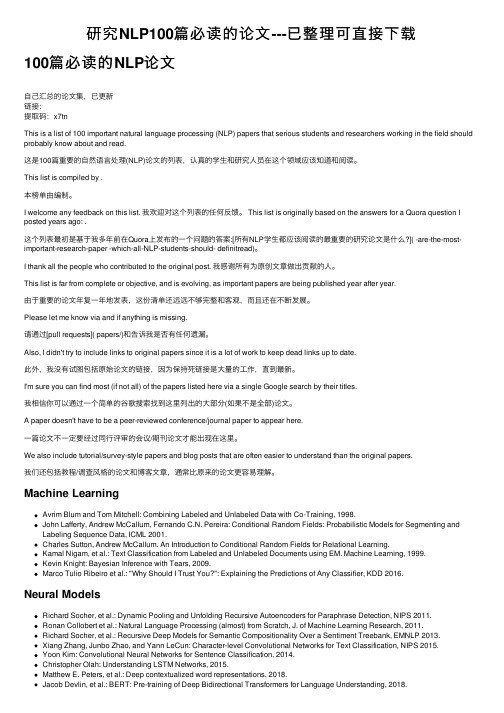
研究NLP100篇必读的论⽂---已整理可直接下载100篇必读的NLP论⽂⾃⼰汇总的论⽂集,已更新链接:提取码:x7tnThis is a list of 100 important natural language processing (NLP) papers that serious students and researchers working in the field should probably know about and read.这是100篇重要的⾃然语⾔处理(NLP)论⽂的列表,认真的学⽣和研究⼈员在这个领域应该知道和阅读。
This list is compiled by .本榜单由编制。
I welcome any feedback on this list. 我欢迎对这个列表的任何反馈。
This list is originally based on the answers for a Quora question I posted years ago: .这个列表最初是基于我多年前在Quora上发布的⼀个问题的答案:[所有NLP学⽣都应该阅读的最重要的研究论⽂是什么?]( -are-the-most-important-research-paper -which-all-NLP-students-should- definitread)。
I thank all the people who contributed to the original post. 我感谢所有为原创⽂章做出贡献的⼈。
This list is far from complete or objective, and is evolving, as important papers are being published year after year.由于重要的论⽂年复⼀年地发表,这份清单还远远不够完整和客观,⽽且还在不断发展。
Speech-to-text and speech-to-speech summarization of spontaneous speech
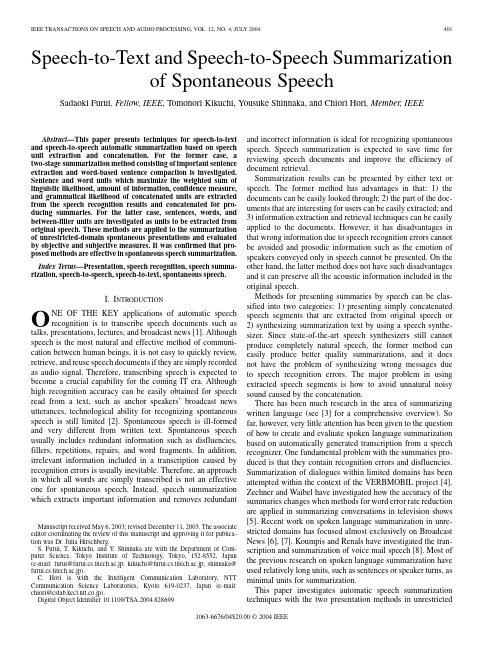
Speech-to-Text and Speech-to-Speech Summarizationof Spontaneous SpeechSadaoki Furui,Fellow,IEEE,Tomonori Kikuchi,Yousuke Shinnaka,and Chiori Hori,Member,IEEEAbstract—This paper presents techniques for speech-to-text and speech-to-speech automatic summarization based on speech unit extraction and concatenation.For the former case,a two-stage summarization method consisting of important sentence extraction and word-based sentence compaction is investigated. Sentence and word units which maximize the weighted sum of linguistic likelihood,amount of information,confidence measure, and grammatical likelihood of concatenated units are extracted from the speech recognition results and concatenated for pro-ducing summaries.For the latter case,sentences,words,and between-filler units are investigated as units to be extracted from original speech.These methods are applied to the summarization of unrestricted-domain spontaneous presentations and evaluated by objective and subjective measures.It was confirmed that pro-posed methods are effective in spontaneous speech summarization. Index Terms—Presentation,speech recognition,speech summa-rization,speech-to-speech,speech-to-text,spontaneous speech.I.I NTRODUCTIONO NE OF THE KEY applications of automatic speech recognition is to transcribe speech documents such as talks,presentations,lectures,and broadcast news[1].Although speech is the most natural and effective method of communi-cation between human beings,it is not easy to quickly review, retrieve,and reuse speech documents if they are simply recorded as audio signal.Therefore,transcribing speech is expected to become a crucial capability for the coming IT era.Although high recognition accuracy can be easily obtained for speech read from a text,such as anchor speakers’broadcast news utterances,technological ability for recognizing spontaneous speech is still limited[2].Spontaneous speech is ill-formed and very different from written text.Spontaneous speech usually includes redundant information such as disfluencies, fillers,repetitions,repairs,and word fragments.In addition, irrelevant information included in a transcription caused by recognition errors is usually inevitable.Therefore,an approach in which all words are simply transcribed is not an effective one for spontaneous speech.Instead,speech summarization which extracts important information and removes redundantManuscript received May6,2003;revised December11,2003.The associate editor coordinating the review of this manuscript and approving it for publica-tion was Dr.Julia Hirschberg.S.Furui,T.Kikuchi,and Y.Shinnaka are with the Department of Com-puter Science,Tokyo Institute of Technology,Tokyo,152-8552,Japan (e-mail:furui@furui.cs.titech.ac.jp;kikuchi@furui.cs.titech.ac.jp;shinnaka@ furui.cs.titech.ac.jp).C.Hori is with the Intelligent Communication Laboratory,NTT Communication Science Laboratories,Kyoto619-0237,Japan(e-mail: chiori@cslab.kecl.ntt.co.jp).Digital Object Identifier10.1109/TSA.2004.828699and incorrect information is ideal for recognizing spontaneous speech.Speech summarization is expected to save time for reviewing speech documents and improve the efficiency of document retrieval.Summarization results can be presented by either text or speech.The former method has advantages in that:1)the documents can be easily looked through;2)the part of the doc-uments that are interesting for users can be easily extracted;and 3)information extraction and retrieval techniques can be easily applied to the documents.However,it has disadvantages in that wrong information due to speech recognition errors cannot be avoided and prosodic information such as the emotion of speakers conveyed only in speech cannot be presented.On the other hand,the latter method does not have such disadvantages and it can preserve all the acoustic information included in the original speech.Methods for presenting summaries by speech can be clas-sified into two categories:1)presenting simply concatenated speech segments that are extracted from original speech or 2)synthesizing summarization text by using a speech synthe-sizer.Since state-of-the-art speech synthesizers still cannot produce completely natural speech,the former method can easily produce better quality summarizations,and it does not have the problem of synthesizing wrong messages due to speech recognition errors.The major problem in using extracted speech segments is how to avoid unnatural noisy sound caused by the concatenation.There has been much research in the area of summarizing written language(see[3]for a comprehensive overview).So far,however,very little attention has been given to the question of how to create and evaluate spoken language summarization based on automatically generated transcription from a speech recognizer.One fundamental problem with the summaries pro-duced is that they contain recognition errors and disfluencies. Summarization of dialogues within limited domains has been attempted within the context of the VERBMOBIL project[4]. Zechner and Waibel have investigated how the accuracy of the summaries changes when methods for word error rate reduction are applied in summarizing conversations in television shows [5].Recent work on spoken language summarization in unre-stricted domains has focused almost exclusively on Broadcast News[6],[7].Koumpis and Renals have investigated the tran-scription and summarization of voice mail speech[8].Most of the previous research on spoken language summarization have used relatively long units,such as sentences or speaker turns,as minimal units for summarization.This paper investigates automatic speech summarization techniques with the two presentation methods in unrestricted1063-6676/04$20.00©2004IEEEdomains.In both cases,the most appropriate sentences,phrases or word units/segments are automatically extracted from orig-inal speech and concatenated to produce a summary under the constraint that extracted units cannot be reordered or replaced. Only when the summary is presented by text,transcription is modified into a written editorial article style by certain rules.When the summary is presented by speech,a waveform concatenation-based method is used.Although prosodic features such as accent and intonation could be used for selection of important parts,reliable methods for automatic and correct extraction of prosodic features from spontaneous speech and for modeling them have not yet been established.Therefore,in this paper,input speech is automat-ically recognized and important segments are extracted based only on the textual information.Evaluation experiments are performed using spontaneous presentation utterances in the Corpus of Spontaneous Japanese (CSJ)made by the Spontaneous Speech Corpus and Processing Project[9].The project began in1999and is being conducted over a five-year period with the following three major targets.1)Building a large-scale spontaneous speech corpus(CSJ)consisting of roughly7M words with a total speech length of700h.This mainly records monologues such as lectures,presentations and news commentaries.The recordings with low spontaneity,such as those from read text,are excluded from the corpus.The utterances are manually transcribed orthographically and phonetically.One-tenth of them,called Core,are tagged manually and used for training a morphological analysis and part-of-speech(POS)tagging program for automati-cally analyzing all of the700-h utterances.The Core is also tagged with para-linguistic information including intonation.2)Acoustic and language modeling for spontaneous speechunderstanding using linguistic,as well as para-linguistic, information in speech.3)Investigating spontaneous speech summarization tech-nology.II.S UMMARIZATION W ITH T EXT P RESENTATIONA.Two-Stage Summarization MethodFig.1shows the two-stage summarization method consisting of important sentence extraction and sentence compaction[10]. Using speech recognition results,the score for important sen-tence extraction is calculated for each sentence.After removing all the fillers,a set of relatively important sentences is extracted, and sentence compaction using our proposed method[11],[12] is applied to the set of extracted sentences.The ratio of sentence extraction and compaction is controlled according to a summa-rization ratio initially determined by the user.Speech summarization has a number of significant chal-lenges that distinguish it from general text summarization. Applying text-based technologies to speech is not always workable and often they are not equipped to capture speech specific phenomena.Speech contains a number of spontaneous effects,which are not present in written language,such as hesitations,false starts,and fillers.Speech is,to someextent,Fig. 1.A two-stage automatic speech summarization system with text presentation.always distorted by ungrammatical and various redundant expressions.Speech is also a continuous phenomenon that comes without unambiguous sentence boundaries.In addition, errors in transcriptions of automatic speech recognition engines can be quite substantial.Sentence extraction methods on which most of the text summarization methods[13]are based cannot cope with the problems of distorted information and redundant expressions in speech.Although several sentence compression methods have also been investigated in text summarization[14],[15], they rely on discourse and grammatical structures of the input text.Therefore,it is difficult to apply them to spontaneous speech with ill-formed structures.The method proposed in this paper is suitable for applying to ill-formed speech recognition results,since it simultaneously uses various statistical features, including a confidence measure of speech recognition results. The principle of the speech-to-text summarization method is also used in the speech-to-speech summarization which will be described in the next section.Speech-to-speech summarization is a comparatively much younger discipline,and has not yet been investigated in the same framework as the speech-to-text summarization.1)Important Sentence Extraction:Important sentence ex-traction is performed according to the following score for eachsentence,obtained as a result of speechrecognition(1)where is the number of words in thesentenceand, ,and are the linguistic score,the significance score,and the confidence score ofword,respectively. Although sentence boundaries can be estimated using linguistic and prosodic information[16],they are manually given in the experiments in this paper.The three scores are a subset of the scores originally used in our sentence compaction method and considered to be useful also as measures indicating theFURUI et al.:SPEECH-TO-TEXT AND SPEECH-TO-SPEECH SUMMARIZATION 403appropriateness of including the sentence in thesummary.and are weighting factors for balancing the scores.Details of the scores are as follows.Linguistic score :The linguisticscore indicates the linguistic likelihood of word strings in the sentence and is measured by n-gramprobability(2)In our experiment,trigram probability calculated using transcriptions of presentation utterances in the CSJ con-sisting of 1.5M morphemes (words)is used.This score de-weights linguistically unnatural word strings caused by recognition errors.Significance score :The significancescoreindicates the significance of eachword in the sentence and is measured by the amount of information.The amount of in-formation contained in each word is calculated for content words including nouns,verbs,adjectives and out-of-vocab-ulary (OOV)words,based on word occurrence in a corpus as shown in (3).The POS information for each word is ob-tained from the recognition result,since every word in the dictionary is accompanied with a unique POS tag.A flat score is given to other words,and(3)where is the number of occurrencesof in the recog-nizedutterances,is the number of occurrencesof ina large-scale corpus,andis the number of all content words in that corpus,thatis.For measuring the significance score,the number of occurrences of 120000kinds of words is calculated in a corpus consisting of transcribed presentations (1.5M words),proceedings of 60presentations,presentation records obtained from the World-Wide Web (WWW)(2.1M words),NHK (Japanese broadcast company)broadcast news text (22M words),Mainichi newspaper text (87M words)and text from a speech textbook “Speech Information Processing ”(51000words).Im-portant keywords are weighted and the words unrelated to the original content,such as recognition errors,are de-weighted by this score.Confidence score :The confidencescoreis incor-porated to weight acoustically as well as linguistically re-liable hypotheses.Specifically,a logarithmic value of the posterior probability for each transcribed word,which is the ratio of a word hypothesis probability to that of all other hypotheses,is calculated using a word graph obtained by a decoder and used as a confidence score.2)Sentence Compaction:After removing relatively less important sentences,the remaining transcription is auto-matically modified into a written editorial article style to calculate the score for sentence compaction.All the sentences are concatenated while preserving sentence boundaries,and a linguisticscore,,a significancescore ,and aconfidencescoreare given to each transcribed word.A word concatenationscorefor every combination of words within each transcribed sentence is also given to weighta word concatenation between words.This score is a measure of the dependency between two words and is obtained by a phrase structure grammar,stochastic dependency context-free grammar (SDCFG).A set of words that maximizes a weighted sum of these scores is selected according to a given compres-sion ratio and connected to create a summary using a two-stage dynamic programming (DP)technique.Specifically,each sentence is summarized according to all possible compression ratios,and then the best combination of summarized sentences is determined according to a target total compression ratio.Ideally,the linguistic score should be calculated using a word concatenation model based on a large-scale summary corpus.Since such a summary corpus is not yet available,the tran-scribed presentations used to calculate the word trigrams for the important sentence extraction are automatically modified into a written editorial article style and used together with the pro-ceedings of 60presentations to calculate the trigrams.The significance score is calculated using the same corpus as that used for calculating the score for important sentence extraction.The word-dependency probability is estimated by the Inside-Outside algorithm,using a manually parsed Mainichi newspaper corpus having 4M sentences with 68M words.For the details of the SDCFG and dependency scores,readers should refer to [12].B.Evaluation Experiments1)Evaluation Set:Three presentations,M74,M35,and M31,in the CSJ by male speakers were summarized at summarization ratios of 70%and 50%.The summarization ratio was defined as the ratio of the number of characters in the summaries to that in the recognition results.Table I shows features of the presentations,that is,length,mean word recognition accuracy,number of sentences,number of words,number of fillers,filler ratio,and number of disfluencies including repairs of each presentation.They were manually segmented into sentences before recognition.The table shows that the presentation M35has a significantly large number of disfluencies and a low recognition accuracy,and M31has a significantly high filler ratio.2)Summarization Accuracy:To objectively evaluate the summaries,correctly transcribed presentation speech was manually summarized by nine human subjects to create targets.Devising meaningful evaluation criteria and metrics for speech summarization is a problematic issue.Speech does not have explicit sentence boundaries in contrast with text input.There-fore,speech summarization results cannot be evaluated using the F-measure based on sentence units.In addition,since words (morphemes)within sentences are extracted and concatenated in the summarization process,variations of target summaries made by human subjects are much larger than those using the sentence level method.In almost all cases,an “ideal ”summary does not exist.For these reasons,variations of the manual summarization results were merged into a word network as shown in Fig.2,which is considered to approximately express all possible correct summaries covering subjective variations.Word accuracy of the summary is then measured in comparison with the closest word string extracted from the word network as the summarization accuracy [5].404IEEE TRANSACTIONS ON SPEECH AND AUDIO PROCESSING,VOL.12,NO.4,JULY 2004TABLE I E V ALUATION SETFig.2.Word network made by merging manual summarization results.3)Evaluation Conditions:Summarization was performed under the following nine conditions:single-stage summariza-tion without applying the important sentence extraction (NOS);two-stage summarization using seven kinds of the possible combination of scores for important sentence extraction(,,,,,,);and summarization by randomword selection.The weightingfactorsand were set at optimum values for each experimental condition.C.Evaluation Results1)Summarization Accuracy:Results of the evaluation ex-periments are shown in Figs.3and 4.In all the automatic summarization conditions,both the one-stage method without sentence extraction and the two-stage method including sen-tence extraction achieve better results than random word se-lection.In both the 70%and 50%summarization conditions,the two-stage method achieves higher summarization accuracy than the one-stage method.The two-stage method is more ef-fective in the condition of the smaller summarization ratio (50%),that is,where there is a higher compression ratio,than in the condition of the larger summarization ratio (70%).In the 50%summarization condition,the two-stage method is effective for all three presentations.The two-stage method is especially effective for avoiding one of the problems of the one-stage method,that is,the production of short unreadable and/or incomprehensible sentences.Comparing the three scores for sentence extraction,the sig-nificancescoreis more effective than the linguisticscore and the confidencescore .The summarization score can beincreased by using the combination of two scores(,,),and even more by combining all threescores.Fig. 3.Results of the summarization with text presentation at 50%summarizationratio.Fig. 4.Results of the summarization with text presentation at 70%summarization ratio.FURUI et al.:SPEECH-TO-TEXT AND SPEECH-TO-SPEECH SUMMARIZATION405The differences are,however,statistically insignificant in these experiments,due to the limited size of the data.2)Effects of the Ratio of Compression by Sentence Extrac-tion:Figs.5and6show the summarization accuracy as a function of the ratio of compression by sentence extraction for the total summarization ratios of50%or70%.The left and right ends of the figures correspond to summarizations by only sentence compaction and sentence extraction,respectively. These results indicate that although the best summarization accuracy of each presentation can be obtained at a different ratio of compression by sentence extraction,there is a general tendency where the smaller the summarization ratio becomes, the larger the optimum ratio of compression by sentence extraction becomes.That is,sentence extraction becomes more effective when the summarization ratio gets smaller. Comparing results at the left and right ends of the figures, summarization by word extraction(i.e.,sentence compaction) is more effective than sentence extraction for the M35presenta-tion.This presentation includes a relatively large amount of re-dundant information,such as disfluencies and repairs,and has a significantly low recognition accuracy.These results indicate that the optimum division of the compression ratio into the two summarization stages needs to be estimated according to the specific summarization ratio and features of the presentation in question,such as frequency of disfluencies.III.S UMMARIZATION W ITH S PEECH P RESENTATIONA.Unit Selection and Concatenation1)Units for Extraction:The following issues need to be ad-dressed in extracting and concatenating speech segments for making summaries.1)Units for extraction:sentences,phrases,or words.2)Criteria for measuring the importance of units forextraction.3)Concatenation methods for making summary speech. The following three units are investigated in this paper:sen-tences,words,and between-filler units.All the fillers automat-ically detected as the result of recognition are removed before extracting important segments.Sentence units:The method described in Section II-A.1 is applied to the recognition results to extract important sentences.Since sentences are basic linguistic as well as acoustic units,it is easy to maintain acoustical smoothness by using sentences as units,and therefore the concatenated speech sounds natural.However,since the units are rela-tively long,they tend to include unnecessary words.Since fillers are automatically removed even if they are included within sentences as described above,the sentences are cut and shortened at the position of fillers.Word units:Word sets are extracted and concatenated by applying the method described in Section II-A.2to the recognition results.Although this method has an advan-tage in that important parts can be precisely extracted in small units,it tends to cause acoustical discontinuity since many small units of speech need to be concatenated.There-fore,summarization speech made by this method some-times soundsunnatural.Fig.5.Summarization accuracy as a function of the ratio of compression by sentence extraction for the total summarization ratio of50%.Fig.6.Summarization accuracy as a function of the ratio of compression by sentence extraction for the total summarization ratio of70%.Between-filler units:Speech segments between fillers as well as sentence boundaries are extracted using speech recognition results.The same method as that used for ex-tracting sentence units is applied to evaluate these units.These units are introduced as intermediate units between sentences and words,in anticipation of both reasonably precise extraction of important parts and naturalness of speech with acoustic continuity.2)Unit Concatenation:Units for building summarization speech are extracted from original speech by using segmentation boundaries obtained from speech recognition results.When the units are concatenated at the inside of sentences,it may produce noise due to a difference of amplitudes of the speech waveforms. In order to avoid this problem,amplitudes of approximately 20-ms length at the unit boundaries are gradually attenuated before the concatenation.Since this causes an impression of406IEEE TRANSACTIONS ON SPEECH AND AUDIO PROCESSING,VOL.12,NO.4,JULY 2004TABLE IIS UMMARIZATION A CCURACY AND N UMBER OF U NITS FOR THE T HREE K INDS OF S UMMARIZATION UNITSincreasing the speaking rate and thus creates an unnatural sound,a short pause is inserted.The length of the pause is controlled between 50and 100ms empirically according to the concatenation conditions.Each summarization speech which has been made by this method is hereafter referred to as “summarization speech sentence ”and the text corresponding to its speech period is referred to as “summarization text sentence.”The summarization speech sentences are further concate-nated to create a summarized speech for the whole presentation.Speech waveforms at sentence boundaries are gradually at-tenuated and pauses are inserted between the sentences in the same way as the unit concatenation within sentences.Short and long pauses with 200-and 700-ms lengths are used as pauses between sentences.Long pauses are inserted after sentence ending expressions,otherwise short pauses are used.In the case of summarization by word-unit concatenation,long pauses are always used,since many sentences terminate with nouns and need relatively long pauses to make them sound natural.B.Evaluation Experiments1)Experimental Conditions:The three presentations,M74,M35,and M31,were automatically summarized with a summarization ratio of 50%.Summarization accuracies for the three presentations using sentence units,between-filler units,and word units,are given in Table II.Manual summaries made by nine human subjects were used for the evaluation.The table also shows the number of automatically detected units in each condition.For the case of using the between-filler units,the number of detected fillers is also shown.Using the summarization text sentences,speech segments were extracted and concatenated to build summarization speech,and subjective evaluation by 11subjects was performed in terms of ease of understanding and appropriateness as a sum-marization with five levels:1—very bad;2—bad;3—normal;4—good;and 5—very good.The subjects were instructed to read the transcriptions of the presentations and understand the contents before hearing the summarizationspeech.Fig.7.Evaluation results for the summarization with speech presentation in terms of the ease ofunderstanding.Fig.8.Evaluation results for the summarization with speech presentation in terms of the appropriateness as a summary.2)Evaluation Results and Discussion:Figs.7and 8show the evaluation results.Averaging over the three presentations,the sentence units show the best results whereas the word unitsFURUI et al.:SPEECH-TO-TEXT AND SPEECH-TO-SPEECH SUMMARIZATION407show the worst.For the two presentations,M74and M35,the between-filler units achieve almost the same results as the sen-tence units.The reason why the word units which show slightly better summarization accuracy in Table II also show the worst subjective evaluation results here is because of unnatural sound due to the concatenation of short speech units.The relatively large number of fillers included in the presentation M31pro-duced many short units when the between-filler unit method was applied.This is the reason why between-filler units show worse subjective results than the sentence units for M31.If the summarization ratio is set lower than50%,between-filler units are expected to achieve better results than sentence units,since sentence units cannot remove redundant expressions within sentences.IV.C ONCLUSIONIn this paper,we have presented techniques for com-paction-based automatic speech summarization and evaluation results for summarizing spontaneous presentations.The sum-marization results are presented by either text or speech.In the former case,the speech-to-test summarization,we proposed a two-stage automatic speech summarization method consisting of important sentence extraction and word-based sentence compaction.In this method,inadequate sentences including recognition errors and less important information are automat-ically removed before sentence compaction.It was confirmed that in spontaneous presentation speech summarization at70% and50%summarization ratios,combining sentence extraction with sentence compaction is effective;this method achieves better summarization performance than our previous one-stage method.It was also confirmed that three scores,the linguistic score,the word significance score and the word confidence score,are effective for extracting important sentences.The best division for the summarization ratio into the ratios of sentence extraction and sentence compaction depends on the summarization ratio and features of presentation utterances. For the case of presenting summaries by speech,the speech-to-speech summarization,three kinds of units—sen-tences,words,and between-filler units—were investigated as units to be extracted from original speech and concatenated to produce the summaries.A set of units is automatically extracted using the same measures used in the speech-to-text summarization,and the speech segments corresponding to the extracted units are concatenated to produce the summaries. Amplitudes of speech waveforms at the boundaries are grad-ually attenuated and pauses are inserted before concatenation to avoid acoustic discontinuity.Subjective evaluation results for the50%summarization ratio indicated that sentence units achieve the best subjective evaluation score.Between-filler units are expected to achieve good performance when the summarization ratio becomes smaller.As stated in the introduction,speech summarization tech-nology can be applied to any kind of speech document and is expected to play an important role in building various speech archives including broadcast news,lectures,presentations,and interviews.Summarization and question answering(QA)per-form a similar task,in that they both map an abundance of information to a(much)smaller piece to be presented to the user[17].Therefore,speech summarization research will help the advancement of QA systems using speech documents.By condensing important points of long presentations and lectures, speech-to-speech summarization can provide the listener with a valuable means for absorbing much information in a much shorter time.Future research includes evaluation by a large number of presentations at various summarization ratios including smaller ratios,investigation of other information/features for impor-tant unit extraction,methods for automatically segmenting a presentation into sentence units[16],those methods’effects on summarization accuracy,and automatic optimization of the division of compression ratio into the two summarization stages according to the summarization ratio and features of the presentation.A CKNOWLEDGMENTThe authors would like to thank NHK(Japan Broadcasting Corporation)for providing the broadcast news database.R EFERENCES[1]S.Furui,K.Iwano,C.Hori,T.Shinozaki,Y.Saito,and S.Tamura,“Ubiquitous speech processing,”in Proc.ICASSP2001,vol.1,Salt Lake City,UT,2001,pp.13–16.[2]S.Furui,“Recent advances in spontaneous speech recognition and un-derstanding,”in Proc.ISCA-IEEE Workshop on Spontaneous Speech Processing and Recognition,Tokyo,Japan,2003.[3]I.Mani and M.T.Maybury,Eds.,Advances in Automatic Text Summa-rization.Cambridge,MA:MIT Press,1999.[4]J.Alexandersson and P.Poller,“Toward multilingual protocol genera-tion for spontaneous dialogues,”in Proc.INLG-98,Niagara-on-the-lake, Canada,1998.[5]K.Zechner and A.Waibel,“Minimizing word error rate in textual sum-maries of spoken language,”in Proc.NAACL,Seattle,W A,2000.[6]J.S.Garofolo,E.M.V oorhees,C.G.P.Auzanne,and V.M.Stanford,“Spoken document retrieval:1998evaluation and investigation of new metrics,”in Proc.ESCA Workshop:Accessing Information in Spoken Audio,Cambridge,MA,1999,pp.1–7.[7]R.Valenza,T.Robinson,M.Hickey,and R.Tucker,“Summarization ofspoken audio through information extraction,”in Proc.ISCA Workshop on Accessing Information in Spoken Audio,Cambridge,MA,1999,pp.111–116.[8]K.Koumpis and S.Renals,“Transcription and summarization of voice-mail speech,”in Proc.ICSLP2000,2000,pp.688–691.[9]K.Maekawa,H.Koiso,S.Furui,and H.Isahara,“Spontaneous speechcorpus of Japanese,”in Proc.LREC2000,Athens,Greece,2000,pp.947–952.[10]T.Kikuchi,S.Furui,and C.Hori,“Two-stage automatic speech summa-rization by sentence extraction and compaction,”in Proc.ISCA-IEEE Workshop on Spontaneous Speech Processing and Recognition,Tokyo, Japan,2003.[11] C.Hori and S.Furui,“Advances in automatic speech summarization,”in Proc.Eurospeech2001,2001,pp.1771–1774.[12] C.Hori,S.Furui,R.Malkin,H.Yu,and A.Waibel,“A statistical ap-proach to automatic speech summarization,”EURASIP J.Appl.Signal Processing,pp.128–139,2003.[13]K.Knight and D.Marcu,“Summarization beyond sentence extraction:A probabilistic approach to sentence compression,”Artific.Intell.,vol.139,pp.91–107,2002.[14]H.Daume III and D.Marcu,“A noisy-channel model for document com-pression,”in Proc.ACL-2002,Philadelphia,PA,2002,pp.449–456.[15] C.-Y.Lin and E.Hovy,“From single to multi-document summarization:A prototype system and its evaluation,”in Proc.ACL-2002,Philadel-phia,PA,2002,pp.457–464.[16]M.Hirohata,Y.Shinnaka,and S.Furui,“A study on important sentenceextraction methods using SVD for automatic speech summarization,”in Proc.Acoustical Society of Japan Autumn Meeting,Nagoya,Japan, 2003.[17]K.Zechner,“Spoken language condensation in the21st Century,”inProc.Eurospeech,Geneva,Switzerland,2003,pp.1989–1992.。
宗成庆--自然语言处理--第一章-绪论
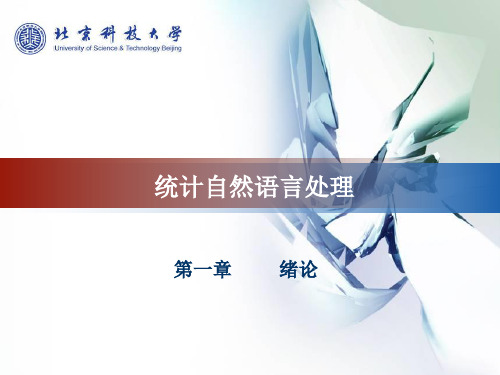
Company Logo
1.2 自然语言处理研究的内容和面临的困难
1.2.1自然语言处理研究的内容; 语言教学(Language teaching):借助计算机辅助 教学工具,进行语言教学、操练和辅导等。 应用:语言学习等 文字识别(Character recognition):通过计算机 系统对印刷体或手写体等文字进行自动识别,将其转 换成计算机可以处理的电子文本基本概念
1.1.1 语言学和语音学; 语音学(phonetics) 研究人类发音特点,特别是语音发音特点,并提出各种语 音描述、分类和转写方法的科学。 包括: (1)发音语音学(articulatory phonetics),研究 发音器官如何产生语音;(2)声学语音学(acoustic phonetics),研究口耳之间传递语音的物理属性;(3) 听觉语音学(auditory phonetics), 研究人通过耳、听 觉神经和大脑对语音的知觉反应。
Company Logo
1.2 自然语言处理研究的内容和面临的困难
——摘自中国金币网(/)
Company Logo
第一章
绪论
计算机发明以来,人类首先想到的计算机的 应用之一,就是自动翻译。然而时至今日,计 算机处理自然语言的能力在大多数情况下都不 能满足人类社会信息化时代的要求。有关专家 指出,语言障碍已经成为制约21世纪社会全球 化发展的一个重要因素。 因此,如何尽早实现自然语言的有效理解, 打破不同语言之间的固有壁垒,已经成为备受 人们关注的极具挑战力的国际前沿研究课题。
Company Logo
1.2 自然语言处理研究的内容和面临的困难
1.2.1自然语言处理研究的内容; 信息检索(Information retrieval):信息检索也称情报检
一种基于潜语义分析的中文网页自动摘要方法_叶昭晖

者可以在潜在语义空间推断出句子与句子之间的相似度或者句子与文档全文之间的相关程度。向量内
k=t
积 Sim( x,y) = x·y = ∑( xk·yk) ,设矩阵 M = ATA,那么矩阵中的元素 M( i,j) 的值是句子 Si与句子 k =1
Sj向量内积,由奇异值分解定理有 M = ATA = ( USVT ) T USVT = VST UT USVT = VS2 VT,句子之间的相似度
随着 Web 信息数量的不断增加,读者在较短时间内快速了解 Web 文章内容的方法为阅读文摘。 文摘是简明、确切地记述原文献重要内容的语义连贯的短文,文摘的特征是忠实原文、语义连贯、语言简 明确切[1]。自动文摘就是利用计算机自动地从原始文献中提取文摘[2],自动文摘技术对于 Web 信息内 容的整理有着重要的意义,尤其是对于中文的 Web 信息。
可以用降维后的对角奇异值矩阵和右奇异矩阵乘积来表示,如果直接由向量内积来结算两个句子之间
的相似度,遇到较长的句子时,会导致准确度下降严重。考虑这个因素,结合实际经验,笔者采用对向量
为了验证上述的假设,笔者将全文作为一个特殊的句子( 对应图 1 中矩阵 A 和 VT 矩阵的阴影部
分) ,与全文其他句子的特征词 T 相乘构成句子 S 的( 其行向量为特征词 T,列向量为句子 S) 。通过对
项 / 文档矩阵的奇异值分解( SVD) ,把高维的向量空间模型( VSM) 表示的文档映射到低维的新空间中,
第2 期
叶昭晖等: 一种基于潜语义分析的中文网页自动摘要方法
343
定义 1 定义 2 征值。 定义 3
如果矩阵 ATA = 1n×n,那么 A = ( aij) m×n 是正交矩阵,这里 AT 是 A 的转置矩阵。 如果矩阵 x ∈ Rn 是 Bn×n 的一个特征向量,并且当 λ ∈ R ,有 Ax = λx ,则 λ 是 Bn×n 的特
研究方向英语

研究方向英语My research focus is on the field of artificial intelligence and machine learning. Specifically, I am interested in developing algorithms and models that can improve the performance of various tasks such as computer vision, natural language processing, and data analysis.One of my main research areas is computer vision, which involves teaching computers to understand and interpret visual data. With the rapid advancement of technology, we are generating vast amounts of visual data every day, such as images and videos. However, extracting meaningful information from this data is a challenging task. Therefore, I aim to develop deep learning models and algorithms that can accurately analyze and interpret this visual data. For example, I am developing models that can recognize objects, detect anomalies, and track movements in real time.In addition to computer vision, I am also focusing on natural language processing (NLP). NLP is a subfield of artificial intelligence that deals with the interaction between computers and human language. The goal is to enable computers to understand, interpret, and generate human language in a way that is similar to human communication. I am particularly interested in developing models and algorithms that can improve automatic text summarization, sentiment analysis, and machine translation. These applications have the potential to greatly enhance information retrieval, decision-making, and communication processes. Furthermore, I am also exploring the use of machine learning in data analysis. With the increasing availability of large datasets, it isbecoming more important to develop efficient algorithms that can extract valuable insights from these data. For instance, I am working on developing models that can analyze complex networks and identify patterns, trends, and anomalies in the data. These insights can then be used to make informed decisions, improve systems, and optimize processes in various domains such as finance, healthcare, and transportation.Overall, my research focus on artificial intelligence and machine learning involves developing models and algorithms that can improve the performance of computer vision, natural language processing, and data analysis tasks. I believe that by advancing these areas, we can solve complex problems, improve decision-making processes, and create smarter and more efficient systems.。
实验1:RIPv1基本配置

RIP动态路由协议动态路由协议包括距离向量路由协议和链路状态路由协议。
RIP(Routing Information Protocol,路由信息协议)是使用最广泛的距离微向量路由协议。
RIP是为小型网络环境设计的,国为这类协议是路由学习及路由更新将产生较大的流量,占用过多的带宽。
4.1RIP概述RIP是由Xerox在20世纪70年代开发的,最初定义在RFC1058中。
RIP用两种数据包传输更新:更新和请求,每个有RIP功能的路由器在默认情况下,每隔30 s利用UDP520端口向与它直连的网络邻居广播(RIPv1)或组播(RIPv2)路由更新。
因此,路由器不知道网络的全局情况,如果路由更新在网络上传播慢,将会导致网络收敛慢,造成路由环路。
为了避免路由环路,RIP采用水平分割、毒性逆转、定义最大跳数、闪式更新和抵制计时5个机制来避免路由环路。
RIP协议分为版本1和片版本2 。
不论是版本1还是版本2,都具备下面的特征:①是距离向量路由协议;②使用跳数(Hop Count)作为度量值;③默认路由更新周期为130 s;④管理距离(AD)为120;⑤支持触发更新;⑥最大跳数为150跳;⑦支持等价路径,默认4条,最大6条;⑧使用UDP520端口进行路由更新。
而RIPv1和RIPv2的区别如表4-1所示。
表4-1 RIPv1和RIPv2的区别RIPv1 RIPv2在路由更新的过程中不携带子网信息在路由更新的过程中携带子网信息不提供认证提供明文和MD5认证不支持VLSM和CIDR 支持VLSM和CIDR采用广播更新采用组播(222.0.0.9)更新有类别(Classful)路由协议无类别(Classless)路由协议4.2 RIPv14.2.1 实验1:RIPv1基本配置1.实验目的通过本实验可以掌握:①在路由器上启动RIPv1路由进程;②启用参与路由协议的接口,并且通告网络;③理解路由表的含义;④查看和调试RIPv1路由协议相关信息。
计算机考研--复试英语
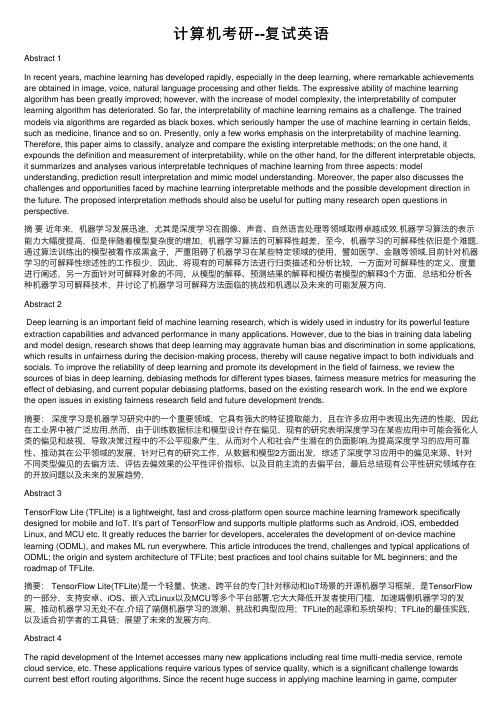
计算机考研--复试英语Abstract 1In recent years, machine learning has developed rapidly, especially in the deep learning, where remarkable achievements are obtained in image, voice, natural language processing and other fields. The expressive ability of machine learning algorithm has been greatly improved; however, with the increase of model complexity, the interpretability of computer learning algorithm has deteriorated. So far, the interpretability of machine learning remains as a challenge. The trained models via algorithms are regarded as black boxes, which seriously hamper the use of machine learning in certain fields, such as medicine, finance and so on. Presently, only a few works emphasis on the interpretability of machine learning. Therefore, this paper aims to classify, analyze and compare the existing interpretable methods; on the one hand, it expounds the definition and measurement of interpretability, while on the other hand, for the different interpretable objects, it summarizes and analyses various interpretable techniques of machine learning from three aspects: model understanding, prediction result interpretation and mimic model understanding. Moreover, the paper also discusses the challenges and opportunities faced by machine learning interpretable methods and the possible development direction in the future. The proposed interpretation methods should also be useful for putting many research open questions in perspective.摘要近年来,机器学习发展迅速,尤其是深度学习在图像、声⾳、⾃然语⾔处理等领域取得卓越成效.机器学习算法的表⽰能⼒⼤幅度提⾼,但是伴随着模型复杂度的增加,机器学习算法的可解释性越差,⾄今,机器学习的可解释性依旧是个难题.通过算法训练出的模型被看作成⿊盒⼦,严重阻碍了机器学习在某些特定领域的使⽤,譬如医学、⾦融等领域.⽬前针对机器学习的可解释性综述性的⼯作极少,因此,将现有的可解释⽅法进⾏归类描述和分析⽐较,⼀⽅⾯对可解释性的定义、度量进⾏阐述,另⼀⽅⾯针对可解释对象的不同,从模型的解释、预测结果的解释和模仿者模型的解释3个⽅⾯,总结和分析各种机器学习可解释技术,并讨论了机器学习可解释⽅法⾯临的挑战和机遇以及未来的可能发展⽅向.Abstract 2Deep learning is an important field of machine learning research, which is widely used in industry for its powerful feature extraction capabilities and advanced performance in many applications. However, due to the bias in training data labeling and model design, research shows that deep learning may aggravate human bias and discrimination in some applications, which results in unfairness during the decision-making process, thereby will cause negative impact to both individuals and socials. To improve the reliability of deep learning and promote its development in the field of fairness, we review the sources of bias in deep learning, debiasing methods for different types biases, fairness measure metrics for measuring the effect of debiasing, and current popular debiasing platforms, based on the existing research work. In the end we explore the open issues in existing fairness research field and future development trends.摘要:深度学习是机器学习研究中的⼀个重要领域,它具有强⼤的特征提取能⼒,且在许多应⽤中表现出先进的性能,因此在⼯业界中被⼴泛应⽤.然⽽,由于训练数据标注和模型设计存在偏见,现有的研究表明深度学习在某些应⽤中可能会强化⼈类的偏见和歧视,导致决策过程中的不公平现象产⽣,从⽽对个⼈和社会产⽣潜在的负⾯影响.为提⾼深度学习的应⽤可靠性、推动其在公平领域的发展,针对已有的研究⼯作,从数据和模型2⽅⾯出发,综述了深度学习应⽤中的偏见来源、针对不同类型偏见的去偏⽅法、评估去偏效果的公平性评价指标、以及⽬前主流的去偏平台,最后总结现有公平性研究领域存在的开放问题以及未来的发展趋势.Abstract 3TensorFlow Lite (TFLite) is a lightweight, fast and cross-platform open source machine learning framework specifically designed for mobile and IoT. It’s part of TensorFlow and supports multiple platforms such as Android, iOS, embedded Linux, and MCU etc. It greatly reduces the barrier for developers, accelerates the development of on-device machine learning (ODML), and makes ML run everywhere. This article introduces the trend, challenges and typical applications of ODML; the origin and system architecture of TFLite; best practices and tool chains suitable for ML beginners; and the roadmap of TFLite.摘要: TensorFlow Lite(TFLite)是⼀个轻量、快速、跨平台的专门针对移动和IoT场景的开源机器学习框架,是TensorFlow 的⼀部分,⽀持安卓、iOS、嵌⼊式Linux以及MCU等多个平台部署.它⼤⼤降低开发者使⽤门槛,加速端侧机器学习的发展,推动机器学习⽆处不在.介绍了端侧机器学习的浪潮、挑战和典型应⽤;TFLite的起源和系统架构;TFLite的最佳实践,以及适合初学者的⼯具链;展望了未来的发展⽅向.Abstract 4The rapid development of the Internet accesses many new applications including real time multi-media service, remote cloud service, etc. These applications require various types of service quality, which is a significant challenge towards current best effort routing algorithms. Since the recent huge success in applying machine learning in game, computervision and natural language processing, many people tries to design “smart” routing algorithms based on machine learning methods. In contrary with traditional model-based, decentralized routing algorithms (e.g.OSPF), machine learning based routing algorithms are usually data-driven, which can adapt to dynamically changing network environments and accommodate different service quality requirements. Data-driven routing algorithms based on machine learning approach have shown great potential in becoming an important part of the next generation network. However, researches on artificial intelligent routing are still on a very beginning stage. In this paper we firstly introduce current researches on data-driven routing algorithms based on machine learning approach, showing the main ideas, application scenarios and pros and cons of these different works. Our analysis shows that current researches are mainly for the principle of machine learning based routing algorithms but still far from deployment in real scenarios. So we then analyze different training and deploying methods for machine learning based routing algorithms in real scenarios and propose two reasonable approaches to train and deploy such routing algorithms with low overhead and high reliability. Finally, we discuss the opportunities and challenges and show several potential research directions for machine learning based routing algorithms in the future.摘要:互联⽹的飞速发展催⽣了很多新型⽹络应⽤,其中包括实时多媒体流服务、远程云服务等.现有尽⼒⽽为的路由转发算法难以满⾜这些应⽤所带来的多样化的⽹络服务质量需求.随着近些年将机器学习⽅法应⽤于游戏、计算机视觉、⾃然语⾔处理获得了巨⼤的成功,很多⼈尝试基于机器学习⽅法去设计智能路由算法.相⽐于传统数学模型驱动的分布式路由算法⽽⾔,基于机器学习的路由算法通常是数据驱动的,这使得其能够适应动态变化的⽹络环境以及多样的性能评价指标优化需求.基于机器学习的数据驱动智能路由算法⽬前已经展⽰出了巨⼤的潜⼒,未来很有希望成为下⼀代互联⽹的重要组成部分.然⽽现有对于智能路由的研究仍然处于初步阶段.⾸先介绍了现有数据驱动智能路由算法的相关研究,展现了这些⽅法的核⼼思想和应⽤场景并分析了这些⼯作的优势与不⾜.分析表明,现有基于机器学习的智能路由算法研究主要针对算法原理,这些路由算法距离真实环境下部署仍然很遥远.因此接下来分析了不同的真实场景智能路由算法训练和部署⽅案并提出了2种合理的训练部署框架以使得智能路由算法能够低成本、⾼可靠性地在真实场景被部署.最后分析了基于机器学习的智能路由算法未来发展中所⾯临的机遇与挑战并给出了未来的研究⽅向.Abstract 5In recent years, the rapid development of Internet technology has greatly facilitated the daily life of human, and it is inevitable that massive information erupts in a blowout. How to quickly and effectively obtain the required information on the Internet is an urgent problem. The automatic text summarization technology can effectively alleviate this problem. As one of the most important fields in natural language processing and artificial intelligence, it can automatically produce a concise and coherent summary from a long text or text set through computer, in which the summary should accurately reflect the central themes of source text. In this paper, we expound the connotation of automatic summarization, review the development of automatic text summarization technique and introduce two main techniques in detail: extractive and abstractive summarization, including feature scoring, classification method, linear programming, submodular function, graph ranking, sequence labeling, heuristic algorithm, deep learning, etc. We also analyze the datasets and evaluation metrics that are commonly used in automatic summarization. Finally, the challenges ahead and the future trends of research and application have been predicted.摘要:近年来,互联⽹技术的蓬勃发展极⼤地便利了⼈类的⽇常⽣活,不可避免的是互联⽹中的信息呈井喷式爆发,如何从中快速有效地获取所需信息显得极为重要.⾃动⽂本摘要技术的出现可以有效缓解该问题,其作为⾃然语⾔处理和⼈⼯智能领域的重要研究内容之⼀,利⽤计算机⾃动地从长⽂本或⽂本集合中提炼出⼀段能准确反映源⽂中⼼内容的简洁连贯的短⽂.探讨⾃动⽂本摘要任务的内涵,回顾和分析了⾃动⽂本摘要技术的发展,针对⽬前主要的2种摘要产⽣形式(抽取式和⽣成式)的具体⼯作进⾏了详细介绍,包括特征评分、分类算法、线性规划、次模函数、图排序、序列标注、启发式算法、深度学习等算法.并对⾃动⽂本摘要常⽤的数据集以及评价指标进⾏了分析,最后对其⾯临的挑战和未来的研究趋势、应⽤等进⾏了预测.Abstract 6With the high-speed development of Internet of things, wearable devices and mobile communication technology, large-scale data continuously generate and converge to multiple data collectors, which influences people’s life in many ways. Meanwhile, it also causes more and more severe privacy leaks. Traditional privacy aware mechanisms such as differential privacy, encryption and anonymization are not enough to deal with the serious situation. What is more, the data convergence leads to data monopoly which hinders the realization of the big data value seriously. Besides, tampered data, single point failure in data quality management and so on may cause untrustworthy data-driven decision-making. How to use big data correctly has become an important issue. For those reasons, we propose the data transparency, aiming to provide solution for the correct use of big data. Blockchain originated from digital currency has the characteristics of decentralization, transparency and immutability, and it provides an accountable and secure solution for data transparency. In this paper, we first propose the definition and research dimension of the data transparency from the perspective of big data life cycle, and we also analyze and summary the methods to realize data transparency. Then, we summary the research progress of blockchain-based data transparency. Finally, we analyze the challenges that may arise in the process of blockchain-based data transparency.摘要:物联⽹、穿戴设备和移动通信等技术的⾼速发展促使数据源源不断地产⽣并汇聚⾄多⽅数据收集者,由此带来更严峻的隐私泄露问题, 然⽽传统的差分隐私、加密和匿名等隐私保护技术还不⾜以应对.更进⼀步,数据的⾃主汇聚导致数据垄断问题,严重影响了⼤数据价值实现.此外,⼤数据决策过程中,数据⾮真实产⽣、被篡改和质量管理过程中的单点失败等问题导致数据决策不可信.如何使这些问题得到有效治理,使数据被正确和规范地使⽤是⼤数据发展⾯临的主要挑战.⾸先,提出数据透明化的概念和研究框架,旨在增加⼤数据价值实现过程的透明性,从⽽为上述问题提供解决⽅案.然后,指出数据透明化的实现需求与区块链的特性天然契合,并对⽬前基于区块链的数据透明化研究现状进⾏总结.最后,对基于区块链的数据透明化可能⾯临的挑战进⾏分析.Abstract 7Blockchain technology is a new emerging technology that has the potential to revolutionize many traditional industries. Since the creation of Bitcoin, which represents blockchain 1.0, blockchain technology has been attracting extensive attention and a great amount of user transaction data has been accumulated. Furthermore, the birth of Ethereum, which represents blockchain 2.0, further enriches data type in blockchain. While the popularity of blockchain technology bringing about a lot of technical innovation, it also leads to many new problems, such as user privacy disclosure and illegal financial activities. However, the public accessible of blockchain data provides unprecedented opportunity for researchers to understand and resolve these problems through blockchain data analysis. Thus, it is of great significance to summarize the existing research problems, the results obtained, the possible research trends, and the challenges faced in blockchain data analysis. To this end, a comprehensive review and summary of the progress of blockchain data analysis is presented. The review begins by introducing the architecture and key techniques of blockchain technology and providing the main data types in blockchain with the corresponding analysis methods. Then, the current research progress in blockchain data analysis is summarized in seven research problems, which includes entity recognition, privacy disclosure risk analysis, network portrait, network visualization, market effect analysis, transaction pattern recognition, illegal behavior detection and analysis. Finally, the directions, prospects and challenges for future research are explored based on the shortcomings of current research.摘要:区块链是⼀项具有颠覆许多传统⾏业的潜⼒的新兴技术.⾃以⽐特币为代表的区块链1.0诞⽣以来,区块链技术获得了⼴泛的关注,积累了⼤量的⽤户交易数据.⽽以以太坊为代表的区块链2.0的诞⽣,更加丰富了区块链的数据类型.区块链技术的⽕热,催⽣了⼤量基于区块链的技术创新的同时也带来许多新的问题,如⽤户隐私泄露,⾮法⾦融活动等.⽽区块链数据公开的特性,为研究⼈员通过分析区块链数据了解和解决相关问题提供了前所未有的机会.因此,总结⽬前区块链数据存在的研究问题、取得的分析成果、可能的研究趋势以及⾯临的挑战具有重要意义.为此,全⾯回顾和总结了当前的区块链数据分析的成果,在介绍区块链技术架构和关键技术的基础上,分析了⽬前区块链系统中主要的数据类型,总结了⽬前区块链数据的分析⽅法,并就实体识别、隐私泄露风险分析、⽹络画像、⽹络可视化、市场效应分析、交易模式识别、⾮法⾏为检测与分析等7个问题总结了当前区块链数据分析的研究进展.最后针对⽬前区块链数据分析研究中存在的不⾜分析和展望了未来的研究⽅向以及⾯临的挑战.Abstract 8In recent years, as more and more large-scale scientific facilities have been built and significant scientific experiments have been carried out, scientific research has entered an unprecedented big data era. Scientific research in big data era is a process of big science, big demand, big data, big computing, and big discovery. It is of important significance to develop a full life cycle data management system for scientific big data. In this paper, we first introduce the background of the development of scientific big data management system. Then we specify the concepts and three key characteristics of scientific big data. After an review of scientific data resource development projects and scientific data management systems, a framework is proposed aiming at the full life cycle management of scientific big data. Further, we introduce the key technologies of the management framework including data fusion, real-time analysis, long termstorage, cloud service, and data opening and sharing. Finally, we summarize the research progress in this field, and look into the application prospects of scientific big data management system.摘要:近年来,随着越来越多的⼤科学装置的建设和重⼤科学实验的开展,科学研究进⼊到⼀个前所未有的⼤数据时代.⼤数据时代科学研究是⼀个⼤科学、⼤需求、⼤数据、⼤计算、⼤发现的过程,研发⼀个⽀持科学⼤数据全⽣命周期的数据管理系统具有重要的意义.分析了研发科学⼤数据管理系统的背景,阐述了科学⼤数据的概念和三⼤特征,通过对科学数据资源发展和科学数据管理系统的研究进展进⾏综述分析,提出了满⾜科学数据管理全⽣命周期的科学⼤数据管理框架,并从数据融合、数据实时分析、长期存储、云服务体系以及数据开放共享机制5个⽅⾯分析了科学⼤数据管理系统中的关键技术.最后,结合科学研究领域展望了科学⼤数据管理系统的应⽤前景.Abstract 9Recently, research on deep learning applied to cyberspace security has caused increasing academic concern, and this survey analyzes the current research situation and trends of deep learning applied to cyberspace security in terms of classification algorithms, feature extraction and learning performance. Currently deep learning is mainly applied to malware detection and intrusion detection, and this survey reveals the existing problems of these applications: feature selection,which could be achieved by extracting features from raw data; self-adaptability, achieved by early-exit strategy to update the model in real time; interpretability, achieved by influence functions to obtain the correspondence between features and classification labels. Then, top 10 obstacles and opportunities in deep learning research are summarized. Based on this, top 10 obstacles and opportunities of deep learning applied to cyberspace security are at first proposed, which falls into three categories. The first category is intrinsic vulnerabilities of deep learning to adversarial attacks and privacy-theft attacks. The second category is sequence-model related problems, including program syntax analysis, program code generation and long-term dependences in sequence modeling. The third category is learning performance problems, including poor interpretability and traceability, poor self-adaptability and self-learning ability, false positives and data unbalance. Main obstacles and their opportunities among the top 10 are analyzed, and we also point out that applications using classification models are vulnerable to adversarial attacks and the most effective solution is adversarial training; collaborative deep learning applications are vulnerable to privacy-theft attacks, and prospective defense is teacher-student model. Finally, future research trends of deep learning applied to cyberspace security are introduced.摘要:近年来,深度学习应⽤于⽹络空间安全的研究逐渐受到国内外学者的关注,从分类算法、特征提取和学习效果等⽅⾯分析了深度学习应⽤于⽹络空间安全领域的研究现状与进展.⽬前,深度学习主要应⽤于恶意软件检测和⼊侵检测两⼤⽅⾯,指出了这些应⽤存在的问题:特征选择问题,需从原始数据中提取更全⾯的特征;⾃适应性问题,可通过early-exit策略对模型进⾏实时更新;可解释性问题,可使⽤影响函数得到特征与分类标签之间的相关性.其次,归纳总结了深度学习发展⾯临的⼗⼤问题与机遇,在此基础上,⾸次归纳了深度学习应⽤于⽹络空间安全所⾯临的⼗⼤问题与机遇,并将⼗⼤问题与机遇归为3类:1)算法脆弱性问题,包括深度学习模型易受对抗攻击和隐私窃取攻击;2)序列化模型相关问题,包括程序语法分析、程序代码⽣成和序列建模长期依赖问题;3)算法性能问题,即可解释性和可追溯性问题、⾃适应性和⾃学习性问题、存在误报以及数据集不均衡的问题.对⼗⼤问题与机遇中主要问题及其解决⽅案进⾏了分析,指出对于分类的应⽤易受对抗攻击,最有效的防御⽅案是对抗训练;基于协作性深度学习进⾏分类的安全应⽤易受隐私窃取攻击,防御的研究⽅向是教师学⽣模型.最后,指出了深度学习应⽤于⽹络空间安全未来的研究发展趋势.。
The use of topic segmentation for automatic summarization
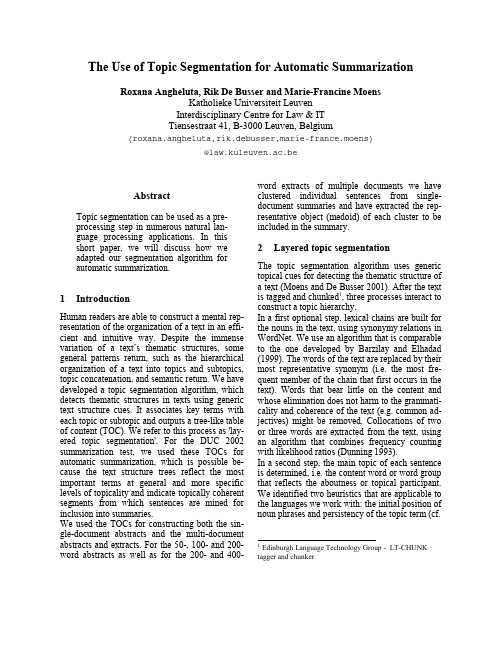
The Use of Topic Segmentation for Automatic Summarization Roxana Angheluta, Rik De Busser and Marie-Francine MoensKatholieke Universiteit LeuvenInterdisciplinary Centre for Law & ITTiensestraat 41, B-3000 Leuven, Belgium{roxana.angheluta,rik.debusser,marie-france.moens}@law.kuleuven.ac.beAbstractTopic segmentation can be used as a pre-processing step in numerous natural lan-guage processing applications. In thisshort paper, we will discuss how weadapted our segmentation algorithm forautomatic summarization.1 IntroductionHuman readers are able to construct a mental rep-resentation of the organization of a text in an effi-cient and intuitive way. Despite the immense variation of a text’s thematic structures, some general patterns return, such as the hierarchical organization of a text into topics and subtopics, topic concatenation, and semantic return. We have developed a topic segmentation algorithm, which detects thematic structures in texts using generic text structure cues. It associates key terms with each topic or subtopic and outputs a tree-like table of content (TOC). We refer to this process as 'lay-ered topic segmentation'. For the DUC 2002 summarization test, we used these TOCs for automatic summarization, which is possible be-cause the text structure trees reflect the most important terms at general and more specific levels of topicality and indicate topically coherent segments from which sentences are mined for inclusion into summaries.We used the TOCs for constructing both the sin-gle-document abstracts and the multi-document abstracts and extracts. For the 50-, 100- and 200-word abstracts as well as for the 200- and 400-word extracts of multiple documents we have clustered individual sentences from single-document summaries and have extracted the rep-resentative object (medoid) of each cluster to be included in the summary.2 Layered topic segmentationThe topic segmentation algorithm uses generic topical cues for detecting the thematic structure of a text (Moens and De Busser 2001). After the text is tagged and chunked1, three processes interact to construct a topic hierarchy.In a first optional step, lexical chains are built for the nouns in the text, using synonymy relations in WordNet. We use an algorithm that is comparable to the one developed by Barzilay and Elhadad (1999). The words of the text are replaced by their most representative synonym (i.e. the most fre-quent member of the chain that first occurs in the text). Words that bear little on the content and whose elimination does not harm to the grammati-cality and coherence of the text (e.g. common ad-jectives) might be removed. Collocations of two or three words are extracted from the text, using an algorithm that combines frequency counting with likelihood ratios (Dunning 1993).In a second step, the main topic of each sentence is determined, i.e. the content word or word group that reflects the aboutness or topical participant. We identified two heuristics that are applicable to the languages we work with: the initial position of noun phrases and persistency of the topic term (cf.1 Edinburgh Language Technology Group - LT-CHUNK tagger and chunkerFigure 1: Example of a table of content made of doc. AP880720-0262.S , set d072fGivón 2001). In languages that primarily have an SVO order – such as English, French and Dutch – noun phrases in a clause-initial position tend to be indicative of the topic of the sentence and of its most important information. Also, the main topic of a sentence usually occurs persistently in con-secutive sentences. Other generic heuristics, such as definiteness or noun phrase embedding will be implemented in the future.A third step in determining the topics and subtop-ics takes into account the distribution of topic terms in the text. It is generally agreed upon that the main topics of a text are signaled by terms that occur throughout the text, while subtopics are sig-naled by terms that are aggregated in limited pas-sages (Hearst 1997).Detection of the main sentence topics and of the term distribution identifies topically coherent segments and aids in detecting topic shifts, nested topics and semantic returns and in finding the most appropriate segmentation.As more information becomes available from these heuristics, a table of content – a tree-like structure indicating the organization of topics and subtopics in a text – is gradually built and cor-rected. For each topic, the coordinates of the cor-responding text segment and topic terms are added (see Figure 1).Layered topic segmentation – i.e. topic segmenta-tion that takes into account topic hierarchies – could be a useful preprocessing step in NLP appli-cations such as information retrieval and informa-tion extraction.3 SummarizationBy restricting the number of levels of the TOC, it could already be used as a kind of short summary. For DUC 2002, we exploit the TOCs for text summarization in alternative ways.For the summarization of single documents we use the hierarchical structure of the TOC: the prede-fined length of the summary dictates the level of topical detail of the summary as it can be derived from the TOCs. The first sentence of each topical segment at the chosen level of detail is included in the summary.For the 10-word abstracts of multiple documents we select the 10 non-redundant topic terms with highest coverage in the articles computed with the coordinates of the TOCs, giving priority to terms that also occur in the articles’ headlines (when they are present) and possibly ordering them as they appear in the original sentences.For the 50-, 100- and 200-word abstracts of multi-ple documents, we start from the summaries of the single texts. We cluster the term vectors of sen-tences (which are restricted to nouns, adjectives and verbs, which are all open word classes) with two different methods: covering and k -medoid. In the covering clustering algorithm possible repre-sentative sentences (medoids) are considered for a potential grouping, each sentence having at least agiven similarity with the medoid of its cluster. Themedoids are included in the summaries (cf. Moens et al. 1999). The objective is to minimize the number of medoids while fitting the predefined length of the summary.The k -medoid method attempts to detect k -clusters for which the total similarity of each sentence and its medoid is maximized. The value k is deter-mined as the clustering that, within the allowed summary length, maximizes the similarity be-tween a sentence and its medoid and minimizes the similarity of the sentence with its second choice cluster.For the 200- and 400-word extracts of multiple documents we cluster the term vectors of the sen-tences of single-document summaries as they oc-cur in the text.4 Results For the DUC 2002 summarization test, we tried to match the length of our summaries as closely as possible to the required word length, which means that we neglected the parameter of brevity. This explains why the mean coverage values obtained for our summaries tend to be better than our mean length adjusted coverage values, unlike the results of other systems (see Figures 2, 4).Evaluation of the single-document summaries gives us some insights into the applicability of the topic segmentation to automatic summarization (see Figure 2). A plot on the coverage for the sin-gle-document summaries is in Figure 3. The single summaries are quite satisfactory given that they are solely based upon the technique of layered topic segmentation.Mean Our team Bestresult WorstresultMean coverage 0.30438 0.361 0.388 0.057Mean length adjusted cover-age 0.25861 0.251 0.339 0.213Mean quality questions 0.64192 0.660 0.407 1.281Figure 2: The complete results for the single-document abstractsFigure 3: The results for the coverage for the single-document abstractsIn some preliminary experiments we tried out re-placing words by representative synonyms, using the WordNet synonym relationships. However, wefound out that neither for single document, nor for multiple document summaries, it did substantially improve the quality. Disregarding grammaticality issues (replacing each member of a lexical chain by the most representative member of a chain can result in an incorrect agreement between nouns as subjects and verbs) the number of good summaries from texts in which words had been replaced bysynonyms is more or less equal to the ones for texts in which no replacements were made. In the DUC corpus the synonym replacement did not affect much the topic segmentation and the subse-quent summaries. With regard to the results sent to the DUC, weonly used synonym replacement for the 10-word abstracts.The results of the 10-word abstracts are not par-ticularly impressive (see Figure 5). This can be explained by the fact that we extracted isolated words rather than phrases, and single words rarely match the peer units used by the human abstract-ers in evaluation.For the multi-document summarization tasks – i.e. for the 50-, 100-, and 200-word abstracts and the 200- and 400-word extracts – we tested two clus-tering algorithms on the term vectors of sentences of the single-document summaries (see Figures 4and 5). Restricting the term vectors to words thatare nouns, verbs or adjectives seems to be fruitful.After more evaluation of the clustering algorithms,it seemed that the covering method performs bet-ter than the k-medoid, but this is a hypothesis that needs further verification.Figure 4: The results for the coverage for the 50-wordmulti-document abstractsMean Our team Best result Worstresult 10-word ab-stractsMean coverage0.18650.0910.3900.091 Mean length adjusted cover-age0.19816 0.060 0.3050.06050-word ab-stractsMean coverage0.16012 0.161 0.2340.100Mean length adjusted cover-age0.149 0.145 0.180 0.102 Mean quality questions 0.77937 0.754 0.461 1.295 100-word ab-stractsMean coverage0.17362 0.141 0.2350.122 Mean length adjusted cover-age0.13525 0.111 0.178 0.094Mean quality questions 0.95837 1.008 0.735 1.259200-word ab-stractsMean coverage0.202 0.165 0.253 0.151Mean length adjusted cover-age0.14912 0.147 0.184 0.104Mean quality questions1.04162 1.085 0.897 1.243Figure 5: The complete results for the multi-document abstractsFor the 200- and 400-word extracts, a consider-able improvement is made by simply using 50-word single summaries for clustering instead of 100-word summaries (see Figures 6, 7).2Mean Our team Best result Worstresult200-word extracts starting with 100-word single-document summariesMean F-measure 0.13210 0.102 0.211 0.042200-word extracts starting with 50-word single-document summaries Mean F-measure 0.137 0.151 0.211 0.042400-word extracts starting with 100-word single-document summariesMean F-measure 0.198 0.179 0.290 0.097 400-word extracts starting with 50-word single-document summaries Mean F-measure 0.2063 0.262 0.290 0.097Figure 6: The complete results for the multi-document extracts2We thank Hans van Halteren for evaluating the extractsbased upon the 50-word single summaries.Figure 7: The F-measure for the 400-word multi-document extractsIn the near future we will evaluate the clustering of single document summaries for multi-document summarization by constructing ideal single sum-maries from 100-word human abstracts and by manually replacing sentences in these abstracts by the sentences from the original texts that best cor-respond to them.Our abstracts still contain a lot of grammatical errors and incohesive passages, and have a rather sloppy organization (see Figures 2, 5, 8). Some of these errors can be attributed to the fact that we have largely neglected the preprocessing of the texts and postprocessing of the summaries. Alto-gether, given the fact that it is the first time that our research group participates in the DUC track and since we primarily focused on a few basic techniques that do not require a priori training, we are quite happy with the results.Figure 8: The mean quality questions errors for the 50-word multi-document abstracts 5 Future improvementsAs far as the topic segmentation of single docu-ments is concerned, we might improve the detec-tion of sentence topics by considering a probabilistic approach. For the abstracts of single and multiple documents, the approach could be refined by condensing the sentences to their essen-tial content without losing their grammatical well-formedness (e.g. especially in the case of direct speech). We will further investigate the effect of the removal of adjectives, adverbs and subclauses on the main propositional content of sentences. Also, the clustering might be refined by bringing back sentences to their more essential proposi-tional content and by finding better cluster me-doids. With regard to multi-document abstracts we want to look into matters of cohesion and more specifically into ways of improving the temporal order of the sentences.6 ConclusionTopic segmentation seems a valuable first step in automatic summarization, especially for summa-rizing expository text. It yields good summaries in the form of TOCs and acceptable summaries of single and multiple documents. The algorithms for topic segmentation and clustering the term vectors of sentences do not require prior training, which gives them the advantage of being generally appli-cable.7 AcknowledgementsWe thank Donna Harman, Paul Over and Hans Van Halteren for their help with the evaluation. ReferencesBarzilay R. & Elhadad M. (1999). Using lexical chains for text summarization. In "Advances in Automatic Text Summarization", I. Mani & M.T. Maybury, eds. MIT Press, Cambridge MA, pp. 111-121. Dunning T. (1993). Accurate methods for the statistics of surprise and coincidence. In Computational Lin-guistics, 19, 61-74.Givón T. (2001). Syntax: Volume II, John Benjamins, Amsterdam.Hearst M.A. (1997). TextTiling: segmenting text into multi-paragraph subtopic passages. In Computa-tional Linguistics 23(1), 33-64.Moens, M.-F. & De Busser R. (2001). Generic topic segmentation of document texts. In “Proceedings of the 24th Annual International ACM SIGIR Confer-ence on Research and Development in Information Retrieval”, ACM, New York, pp. 418-419. Moens, M.-F., Uyttendaele, C., & Dumortier, J. (1999).Abstracting of legal cases: the potential of clustering based on the selection of representative objects. In Journal of the American Society for Information Science 50 (2), 151-161.。
Internet上文本的自动摘要技术_尹存燕
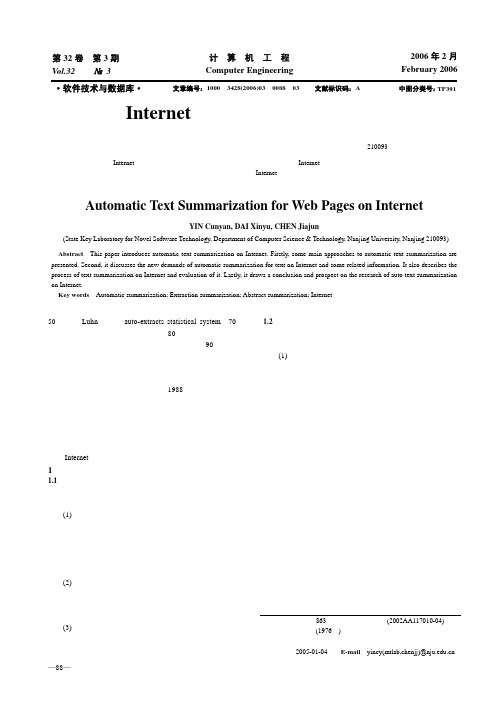
尹存燕,戴新宇,陈家骏
(南京大学计算机软件新技术国家重点实验室,南京大学计算机科学与技术系,南京 210093)
摘 要:主要研究了 Internet 上的文本自动摘要,介绍了自动摘要的主流技术;讨论 Internet 上文本摘要的新需求以及网页上与自动摘要相 关的信息,介绍了摘要处理过程和当前自动摘要的主要评估方法;对 Internet 上文本的自动摘要作出了总结和展望。 关键词:自动摘要;抽取型摘要;概括型摘要;互联网
(2)情报型 情报型摘要概括了文章最重要的内容,其特点是全面、 简要地概括论文的目的、方法、主要数据和结论。情报型摘 要是由系统生成的。 (3)评论型 评论型摘要从摘要者的角度去评价该文章,加入了摘要 者的主观判断,而自动摘要系统要求的是客观地概括原文,
评论型摘要目前还是主要由人工生成。 1.2 自动摘要技术的分类
句子 i 和主题的相似度,并采用 Jaccard’s cofficient 法则来计 算句子与标题的相似度:
句子 i 和标题的相似度 =
Z
X + Y -Z
其中 X 为句子 i 中关键词的个数,Y 为标题中关键词的个数,
Z 为二者相同的关键词的个数。这种方法计算的相似度值也
在 0~1 之间,值越接近 1,则相似度越大。
(2)概括型摘要 概括型摘要中不是所有的句子都来自于原文,有些句子 是在对原文进行深层分析以及根据领域知识进行信息提取的 基础上,利用自然语言生成技术生成的。深层分析方法主要 指的是语法分析、语义分析、语用分析和信息提取。语法分 析是借助词典中的语言学知识对句子进行语法分析,获得语 法结构树;语义分析是利用知识库中的语义知识将语法结构 描述转换成以逻辑和意义为基础的语义表示;语用分析和信 息提取则是根据知识库中预先存放的领域知识在上下文中进 行推理,提取出关键内容[2]。 概括型摘要与抽取型摘要最大的不同是:概括型摘要利 用领域知识对原文进行全面的判断、推理,从而得到其中的 意义表示,它比抽取型摘要对原文有更深的理解。但这同时 也是概括型摘要的难点,因为它显然要受到领域限制,不同 领域的知识获取是件困难的事。并且除了需要自然语言深层 的理解技术之外,还需要自然语言生成技术,所以概括型摘 要实现起来比抽取型摘要困难,目前仍处于研究阶段。 1.3 自动摘要中的浅层方法 浅层方法首先利用统计的方法计算各种与摘要相关的特 征值,之后将这些特征值乘以各自的参数求和就能得到文章 句子的权值。参数可利用机器学习在已有的文摘训练集上获 得。统计特征主要有以下几种: (1) 词 频 。 体 现 文 章 主 题 内 容 的 词 往 往 在 文 章 中 多 处 出 现,在分析文章时往往统计其中词汇的频率。不过在统计词 频 前 , 要 忽 略 停 用 词 (stop-word) , 如 “ 这 个 ”、“ 的 ” 等 。 除 了简单的词频统计之外,还可在概念知识库(如“知网”)的 基础上进行同一个概念的词频统计。概念词频的统计有利于 发现文章的主题。比如“处理器”、“内存”都属于计算机硬 件的范畴。如文章中属于计算机硬件范畴的词汇较多的话, 则可以推测该文章的中心内容应该与计算机有关。频率大的 词将视为关键词,包含关键词越多的句子被抽取的可能性 越大。 (2)句子的位置。句子的位置可以是全文中的位置、在章 节中的位置或在段落中的位置。有研究表明,一篇文章的前 言、结论、第 1 章节、第 1 自然段、最后一段等中的句子作 为摘要的组成可能性要大于其他位置的句子。 (3)线索词。能提示文章主题出现的词称作线索词,如: “本文的目的是”。此外专有名词如人名、机构名等也可看作 是线索词。包含线索词的句子在分析时应给予一定的重视。 (4)句子长度。一篇文章中句子长度(包含的词汇个数)的 平均值是可计算出来的。一个可以作为摘要候选句子其包含 的词数不会很小。考虑一个句子是否作为候选句时,应计算 它的长度和这篇文章平均句长的比值,如这个比值小于某个 阈值,就应该舍弃。这个阈值可通过一定的语料库训练得到。 (5)与标题的相似度。文章中一个句子和文章标题的相似 度越大,则该句被抽取的可能性也就越大。计算句子和标题 相似度的方法中,比较经典的是采用向量模型:将句子 i 和 标题都表示成一个 n 维的向量,其相似度用 cosθ表示[3]:
文本自动摘要与生成的方法及评价研究
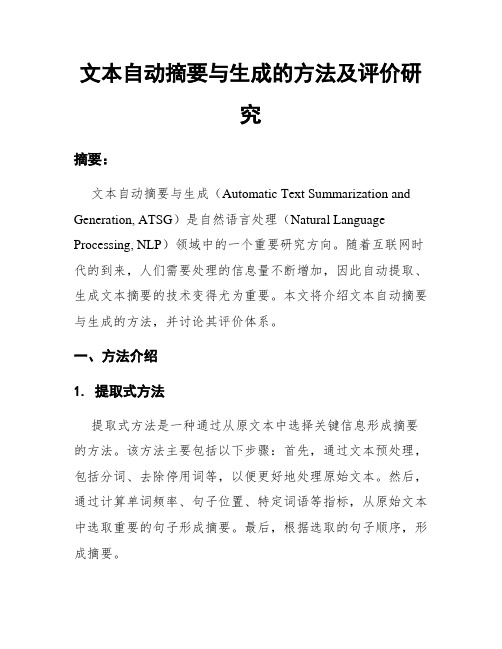
文本自动摘要与生成的方法及评价研究摘要:文本自动摘要与生成(Automatic Text Summarization and Generation, ATSG)是自然语言处理(Natural Language Processing, NLP)领域中的一个重要研究方向。
随着互联网时代的到来,人们需要处理的信息量不断增加,因此自动提取、生成文本摘要的技术变得尤为重要。
本文将介绍文本自动摘要与生成的方法,并讨论其评价体系。
一、方法介绍1. 提取式方法提取式方法是一种通过从原文本中选择关键信息形成摘要的方法。
该方法主要包括以下步骤:首先,通过文本预处理,包括分词、去除停用词等,以便更好地处理原始文本。
然后,通过计算单词频率、句子位置、特定词语等指标,从原始文本中选取重要的句子形成摘要。
最后,根据选取的句子顺序,形成摘要。
2. 抽象式方法抽象式方法是一种通过将原文本中的内容重新组合来生成摘要的方法。
相比于提取式方法,抽象式方法更加灵活,能够生成更加准确和自然的摘要。
该方法主要包括以下步骤:首先,通过文本预处理,将原始文本转换为结构化的表示形式,如句法树或语义图。
然后,基于该结构化表示形式,使用自然语言生成模型生成摘要。
最后,根据生成摘要的质量,进行评价和改进。
二、评价体系1. 内容一致性内容一致性是评价自动摘要与生成质量的重要指标之一。
一个好的摘要应当能够准确地反映原始文本的主要内容,不丢失重要信息。
内核方式和LSA(Latent Semantic Analysis)等方法可以用于评估内容一致性。
2. 多样性多样性是评价自动摘要与生成质量的重要指标之一。
一个好的摘要不仅需要准确地反映原始文本的内容,还应该尽可能展示多样的信息,避免信息的重复。
N-gram方法、命名实体识别等方法可以用于评估多样性。
3. 流畅度流畅度是评价自动摘要与生成质量的重要指标之一。
一个好的摘要应当能够自然流畅地表达信息,具有良好的语法和语义连贯性。
paddlenlp text_summarization 长文本
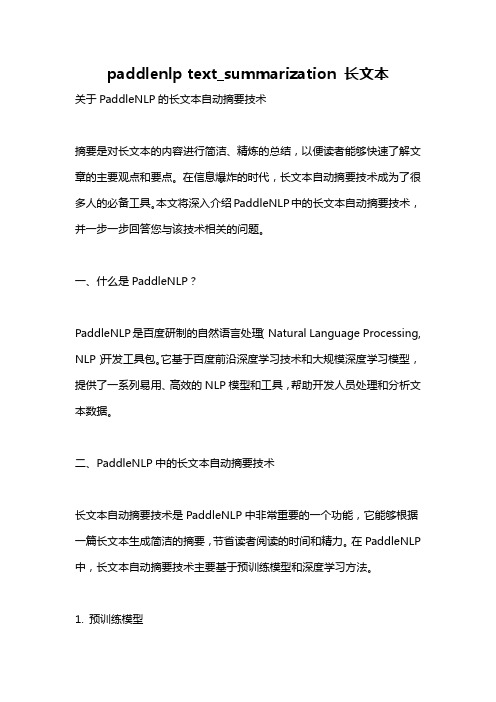
paddlenlp text_summarization 长文本关于PaddleNLP的长文本自动摘要技术摘要是对长文本的内容进行简洁、精炼的总结,以便读者能够快速了解文章的主要观点和要点。
在信息爆炸的时代,长文本自动摘要技术成为了很多人的必备工具。
本文将深入介绍PaddleNLP中的长文本自动摘要技术,并一步一步回答您与该技术相关的问题。
一、什么是PaddleNLP?PaddleNLP是百度研制的自然语言处理(Natural Language Processing, NLP)开发工具包。
它基于百度前沿深度学习技术和大规模深度学习模型,提供了一系列易用、高效的NLP模型和工具,帮助开发人员处理和分析文本数据。
二、PaddleNLP中的长文本自动摘要技术长文本自动摘要技术是PaddleNLP中非常重要的一个功能,它能够根据一篇长文本生成简洁的摘要,节省读者阅读的时间和精力。
在PaddleNLP 中,长文本自动摘要技术主要基于预训练模型和深度学习方法。
1. 预训练模型PaddleNLP中的长文本自动摘要功能主要利用了预训练模型,这些模型通过大规模的文本数据进行预训练,学习到了丰富的语言知识和特征。
这些预训练模型可以直接用于生成摘要,也可以进一步微调以适应具体的任务和数据。
2. 深度学习方法PaddleNLP中的长文本自动摘要技术还利用了深度学习方法。
通过深度学习模型的训练和优化,PaddleNLP可以自动提取文本的重要信息,并生成简洁的摘要。
三、PaddleNLP中的长文本自动摘要技术的应用PaddleNLP中的长文本自动摘要技术可以应用于多个领域,帮助用户快速获取文本信息。
1. 新闻摘要在新闻报道中,往往需要快速了解文章的主题和要点。
PaddleNLP的长文本自动摘要技术可以帮助编辑人员快速生成新闻摘要,提高工作效率。
2. 学术论文阅读学术论文通常篇幅较长,读者需要花费大量时间才能全面了解论文的内容。
ai在线英语写作
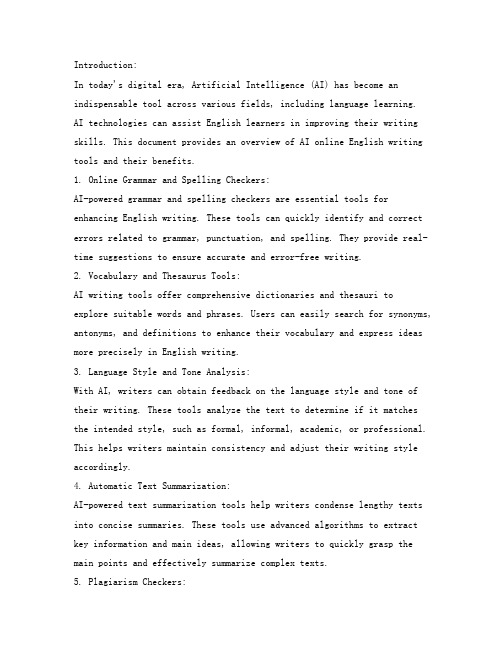
Introduction:In today's digital era, Artificial Intelligence (AI) has become an indispensable tool across various fields, including language learning.AI technologies can assist English learners in improving their writing skills. This document provides an overview of AI online English writing tools and their benefits.1. Online Grammar and Spelling Checkers:AI-powered grammar and spelling checkers are essential tools for enhancing English writing. These tools can quickly identify and correct errors related to grammar, punctuation, and spelling. They provide real-time suggestions to ensure accurate and error-free writing.2. Vocabulary and Thesaurus Tools:AI writing tools offer comprehensive dictionaries and thesauri toexplore suitable words and phrases. Users can easily search for synonyms, antonyms, and definitions to enhance their vocabulary and express ideas more precisely in English writing.3. Language Style and Tone Analysis:With AI, writers can obtain feedback on the language style and tone of their writing. These tools analyze the text to determine if it matches the intended style, such as formal, informal, academic, or professional. This helps writers maintain consistency and adjust their writing style accordingly.4. Automatic Text Summarization:AI-powered text summarization tools help writers condense lengthy texts into concise summaries. These tools use advanced algorithms to extract key information and main ideas, allowing writers to quickly grasp the main points and effectively summarize complex texts.5. Plagiarism Checkers:Avoiding plagiarism is crucial in academic and professional writing. AI-based plagiarism checkers can identify and highlight any instances of copied content, ensuring the originality and integrity of the writing. Writers can confidently submit their work, knowing that it is free from plagiarism.6. Writing Tutor and Language Learning AI Assistants:AI writing tutors act as virtual assistants, providing personalized feedback and suggestions to improve writing skills. These tools analyze the writing and offer suggestions for improving sentence structure, coherence, and clarity. Additionally, language learning AI assistants can help learners practice their English writing skills through interactive exercises and simulations.Conclusion:AI online English writing tools have revolutionized the way individuals learn and improve their writing skills. These tools offer a range of features, including grammar and spelling checkers, vocabulary enhancers, language style and tone analysis, automatic text summarization, plagiarism checkers, and writing tutors. By embracing these AI tools, learners can enhance their English writing abilities, thereby achieving more effective and efficient communication in the English language.。
paddlenlp text_summarization 训练 -回复
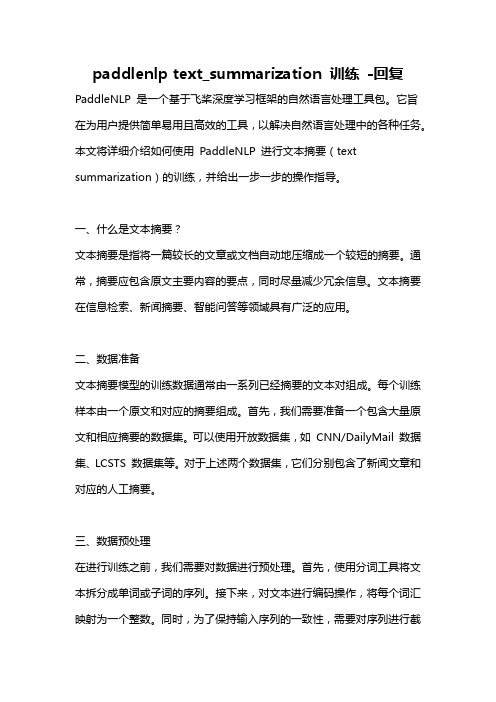
paddlenlp text_summarization 训练-回复PaddleNLP 是一个基于飞桨深度学习框架的自然语言处理工具包。
它旨在为用户提供简单易用且高效的工具,以解决自然语言处理中的各种任务。
本文将详细介绍如何使用PaddleNLP 进行文本摘要(text summarization)的训练,并给出一步一步的操作指导。
一、什么是文本摘要?文本摘要是指将一篇较长的文章或文档自动地压缩成一个较短的摘要。
通常,摘要应包含原文主要内容的要点,同时尽量减少冗余信息。
文本摘要在信息检索、新闻摘要、智能问答等领域具有广泛的应用。
二、数据准备文本摘要模型的训练数据通常由一系列已经摘要的文本对组成。
每个训练样本由一个原文和对应的摘要组成。
首先,我们需要准备一个包含大量原文和相应摘要的数据集。
可以使用开放数据集,如CNN/DailyMail 数据集、LCSTS 数据集等。
对于上述两个数据集,它们分别包含了新闻文章和对应的人工摘要。
三、数据预处理在进行训练之前,我们需要对数据进行预处理。
首先,使用分词工具将文本拆分成单词或子词的序列。
接下来,对文本进行编码操作,将每个词汇映射为一个整数。
同时,为了保持输入序列的一致性,需要对序列进行截断或填充操作。
最后,将原文和摘要分别拆分成输入和输出序列对。
四、模型选择PaddleNLP 提供了丰富的文本摘要模型,包括经典的Seq2Seq 模型、Transformer 模型等。
根据任务需求和性能,可以选择合适的模型进行训练。
五、模型训练首先,我们需要定义一个数据加载器,用于从准备好的数据集中生成训练样本。
PaddleNLP 提供了多种数据加载器,如`paddlenlp.data` 中的`TupleDataset`、`Text2TextDataset` 等。
根据具体需求,选择合适的数据加载器。
接下来,需要构建模型。
使用PaddleNLP 提供的模型库,通过简单的调用即可构建出Seq2Seq 模型或Transformer 模型等。
基于生成式的自动文本摘要方法研究
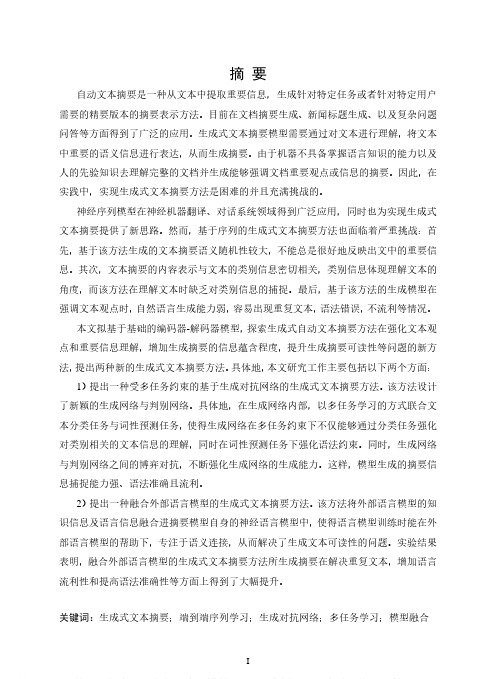
摘要自动文本摘要是一种从文本中提取重要信息,生成针对特定任务或者针对特定用户需要的精要版本的摘要表示方法。
目前在文档摘要生成、新闻标题生成、以及复杂问题问答等方面得到了广泛的应用。
生成式文本摘要模型需要通过对文本进行理解,将文本中重要的语义信息进行表达,从而生成摘要。
由于机器不具备掌握语言知识的能力以及人的先验知识去理解完整的文档并生成能够强调文档重要观点或信息的摘要。
因此,在实践中,实现生成式文本摘要方法是困难的并且充满挑战的。
神经序列模型在神经机器翻译、对话系统领域得到广泛应用,同时也为实现生成式文本摘要提供了新思路。
然而,基于序列的生成式文本摘要方法也面临着严重挑战:首先,基于该方法生成的文本摘要语义随机性较大,不能总是很好地反映出文中的重要信息。
其次,文本摘要的内容表示与文本的类别信息密切相关,类别信息体现理解文本的角度,而该方法在理解文本时缺乏对类别信息的捕捉。
最后,基于该方法的生成模型在强调文本观点时,自然语言生成能力弱,容易出现重复文本,语法错误,不流利等情况。
本文拟基于基础的编码器-解码器模型,探索生成式自动文本摘要方法在强化文本观点和重要信息理解,增加生成摘要的信息蕴含程度,提升生成摘要可读性等问题的新方法,提出两种新的生成式文本摘要方法。
具体地,本文研究工作主要包括以下两个方面:1)提出一种受多任务约束的基于生成对抗网络的生成式文本摘要方法。
该方法设计了新颖的生成网络与判别网络。
具体地,在生成网络内部,以多任务学习的方式联合文本分类任务与词性预测任务,使得生成网络在多任务约束下不仅能够通过分类任务强化对类别相关的文本信息的理解,同时在词性预测任务下强化语法约束。
同时,生成网络与判别网络之间的博弈对抗,不断强化生成网络的生成能力。
这样,模型生成的摘要信息捕捉能力强、语法准确且流利。
2)提出一种融合外部语言模型的生成式文本摘要方法。
该方法将外部语言模型的知识信息及语言信息融合进摘要模型自身的神经语言模型中,使得语言模型训练时能在外部语言模型的帮助下,专注于语义连接,从而解决了生成文本可读性的问题。
机器学习在文本分类中的应用研究(英文中文双语版优质文档)
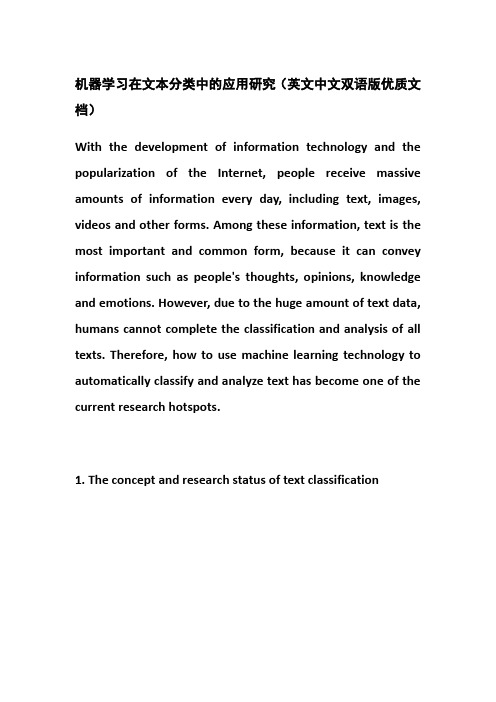
机器学习在文本分类中的应用研究(英文中文双语版优质文档)With the development of information technology and the popularization of the Internet, people receive massive amounts of information every day, including text, images, videos and other forms. Among these information, text is the most important and common form, because it can convey information such as people's thoughts, opinions, knowledge and emotions. However, due to the huge amount of text data, humans cannot complete the classification and analysis of all texts. Therefore, how to use machine learning technology to automatically classify and analyze text has become one of the current research hotspots.1. The concept and research status of text classificationText classification refers to dividing text into pre-defined categories according to the content and characteristics of the text. Text classification is an important research direction in the field of natural language processing and machine learning, with a wide range of application scenarios. At present, the research on text classification mainly includes the following aspects:1.1 Feature ExtractionThe key to text classification is feature extraction, which converts text into numerical features that can be used for machine learning. Traditional text features include word frequency, document frequency, tf-idf, etc., but these features cannot handle long and complex text classification problems. Therefore, in recent years, some text feature extraction methods based on deep learning have emerged, such as convolutional neural network (CNN), recurrent neural network (RNN) and transformer (Transformer), which can automatically learn the abstract features of text, thereby Improve the accuracy of text classification.1.2 Classification modelA classification model is a model that classifies text based on features. Traditional classification models include Naive Bayesian, Support Vector Machine (SVM) and Decision Tree, etc. These models can deal with text classification problems to a certain extent. However, with the development of deep learning technology, some text classification models based on deep learning have emerged, such as convolutional neural network classification model (CNN) and recurrent neural network classification model (RNN). These models perform better when dealing with long text and complex text classification problems.1.3 DatasetData sets are the key to machine learning algorithms. For text classification algorithms, a high-quality data set is essential. Currently, there are many public text classification datasets available, such as 20 Newsgroups dataset, Reuters-21578 dataset and IMDB dataset, etc. These datasets have different characteristics and uses, and can be used for text classification tasks in different fields.2. Application of machine learning in text classificationMachine learning is widely used in text classification, and several typical application scenarios are listed below.2.1 News classificationNews is one of the important ways for people to obtain information, and a large amount of news content is produced every day. In order to make it easier for readers to obtain the news content they are interested in, news websites need to classify news. Using machine learning technology can quickly and accurately classify news and improve user experience.2.2 Sentiment AnalysisSentiment analysis refers to classifying texts into positive, negative, or neutral categories based on their emotional color. Sentiment analysis has a wide range of applications in fields such as business, public opinion monitoring, and emotion recognition. Using machine learning technology can quickly and accurately conduct sentiment analysis on text, so as to better understand the needs and emotions of users.2.3 Spam FilteringSpam is one of the most prevalent threats on the web, consuming a user's network bandwidth and storage space, and may contain malicious links or software. Using machine learning technology can automatically identify and filter spam, so as to ensure the safety of users.2.4 Text matchingText matching refers to finding content in text that matches a given text. Text matching has a wide range of applications in search engines, text recommendation, and intelligent customer service. Machine learning technology can be used to automatically match and recommend text to improve user search experience and satisfaction.3. Challenges and Solutions of Machine Learning in Text ClassificationAlthough machine learning has a wide range of applications in text classification, there are some challenges. A few common challenges are listed below, along with corresponding solutions.3.1 Processing large-scale text dataWith the popularization of the Internet and the development of information technology, the size and complexity of text data are constantly increasing. How to efficiently process large-scale text data has become an important issue. To solve this problem, technologies such as distributed computing, GPU acceleration, and deep learning algorithms can be adopted.3.2 Handling Complex Text StructuresSome texts have more complex structures, such as web pages, news, etc. Processing this kind of text needs to consider the structural information of the text, such as HTML tags, paragraphs, headings, etc. To solve this problem, natural language processing techniques, such as named entity recognition, part-of-speech tagging, etc., and deep learning techniques, such as convolutional neural networks and recurrent neural networks, can be used.3.3 Handling multilingual textWith the development of globalization, the processing of multilingual texts has become an important issue. How to handle multilingual text in machine learning models so that the models can work in different language environments is an important challenge. To solve this problem, techniques such as multilingual word vectors and multilingual models can be used.3.4 Handling Semantically Inconsistent TextIn the text classification task, some texts have the problem of semantic inconsistency, that is, texts of the same category may have different expressions. This situation presents a challenge for machine learning algorithms. In order to solve this problem, technologies such as word vectors and language models can be used for text representation to capture the semantic information of the text.In conclusion, the application of machine learning in text classification is very extensive, but there are also some challenges. Through continuous research and innovation, we can overcome these challenges, improve the accuracy and efficiency of text classification, and bring more convenience and value to people's life and work.随着信息技术的发展和互联网的普及,人们每天都会接收到海量的信息,包括文本、图像、视频等多种形式。
Document Summarization
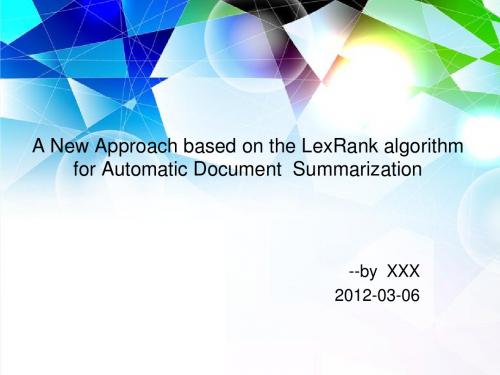
3.1 computing the similarity
Introducing the sentences features, the sentence length and the semantics. Suppose sentence A and B, A includes keyword {x1,x2,..,xm,} and B={ y1,y2,...,yn}
50 TDT English documents from DUC2004
ROUGE-1 原LexRank算法 系统方法 0.3424 0.3711 ROUGE-2 0.0761 0.0925
0.4 0.35 0.3 0.25 0.2 0.15 0.1 0.05 0 ROUGE-1 ROUGE-2 原LexRank算法 系统方法
A New Approach based on the LexRank algorithm for Automatic Document Summarization
--by XXX 2012-03-06
1. Introduction
• Automated summarization dates back to the 1950's[1] by H.P.Luhn from IBM. • Very helpful for people to acquire the key information in a short time, and very useful ina summary describing the majority of information content from a single document or a set of documents .
Document Summarization
paddlenlp text_summarization 长文本 -回复
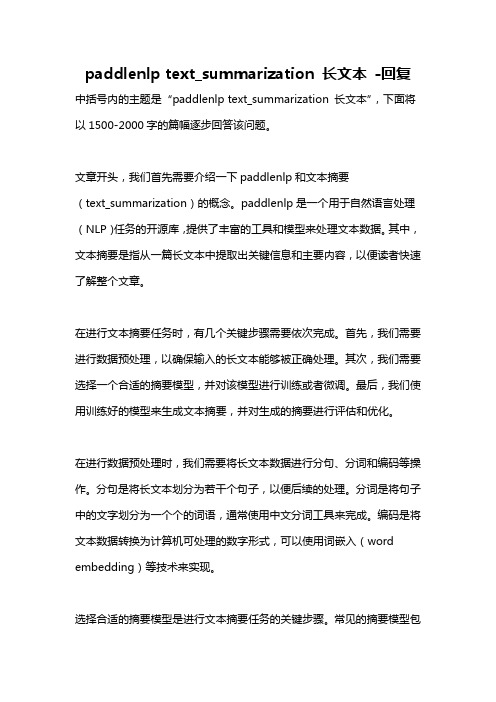
paddlenlp text_summarization 长文本-回复中括号内的主题是“paddlenlp text_summarization 长文本”,下面将以1500-2000字的篇幅逐步回答该问题。
文章开头,我们首先需要介绍一下paddlenlp和文本摘要(text_summarization)的概念。
paddlenlp是一个用于自然语言处理(NLP)任务的开源库,提供了丰富的工具和模型来处理文本数据。
其中,文本摘要是指从一篇长文本中提取出关键信息和主要内容,以便读者快速了解整个文章。
在进行文本摘要任务时,有几个关键步骤需要依次完成。
首先,我们需要进行数据预处理,以确保输入的长文本能够被正确处理。
其次,我们需要选择一个合适的摘要模型,并对该模型进行训练或者微调。
最后,我们使用训练好的模型来生成文本摘要,并对生成的摘要进行评估和优化。
在进行数据预处理时,我们需要将长文本数据进行分句、分词和编码等操作。
分句是将长文本划分为若干个句子,以便后续的处理。
分词是将句子中的文字划分为一个个的词语,通常使用中文分词工具来完成。
编码是将文本数据转换为计算机可处理的数字形式,可以使用词嵌入(word embedding)等技术来实现。
选择合适的摘要模型是进行文本摘要任务的关键步骤。
常见的摘要模型包括传统的统计模型(如TF-IDF)和基于深度学习的模型(如Seq2Seq和Transformer)。
在选择模型时,我们需要考虑模型的性能、复杂度和可解释性等因素,并根据实际需求进行选择。
对于深度学习模型,训练和微调是非常重要的步骤。
在训练模型时,我们需要准备训练数据集,并选择合适的损失函数和优化器来进行模型训练。
在微调模型时,我们可以使用预训练的模型进行初始化,并使用少量的数据进行微调,以获得更好的性能。
模型训练或微调完成后,我们可以使用训练好的模型来生成文本摘要。
生成摘要的过程通常分为两个步骤:编码器将输入的长文本转换为一个向量表示,然后解码器使用该向量生成摘要。
- 1、下载文档前请自行甄别文档内容的完整性,平台不提供额外的编辑、内容补充、找答案等附加服务。
- 2、"仅部分预览"的文档,不可在线预览部分如存在完整性等问题,可反馈申请退款(可完整预览的文档不适用该条件!)。
- 3、如文档侵犯您的权益,请联系客服反馈,我们会尽快为您处理(人工客服工作时间:9:00-18:30)。
<n>. <np>. <v>. <vp>. <ad> alld <adp> lllealt 11o1111.
917
noun phrase, verb, verb I)hr~se, adnoun or adverb (including preposition and postposition), and adnominal or adverl)ial phrase, respectively 1. The GDA initiative aims at having many W W W authors a m m t a t e their on-line documents with this common tag set so that machines can automatically recognize tile underlying sexnantic and pragmatic structures of those documents much nmre easily than by analyzing traditional H T M L files. A huge amount of annotated d a t a is expected to emerge, which should serve not just as tagged linguistic corpora but also as a worldwidc, self-extending knowledge base, mMnly consisting of examples showing how our knowledge is manifested. GDA has three main steps: 1. Propose an XML tag set which allows machines to automatically infer the underlying structure of documents. 2. Promote develoi)ment and spread of N L P / A I applications to turn tagged texts to versatile and intelligcnt contents. 3. Motivate thereby the authors of W W W files to annotate their documents nsing thosc tags.
K6iti Hasida Electrotechnical Laboratory 1-1-4 Ulnezono, Tukuba, Ibaraki 305-8568, Japan hasida@etl.go.jp
Although HTML is a fle.xible tool that allows you to freely write and read messages on the W W W , it is neither very c(mvenient to readers nor suital)h: for automatic 1)roeessing of contents. We have been deveh)t)ing an integrated platfornl for (loeunmnt authoring, t)ul)lishing. &lid reltse by combining natural language and W W W teehnoh)gies. As the first ste l) of our project, we ([efined a new tag set and developed tools for editing tagged texts and browsing these texts. The browser has the functionality of summarization an(l (:ont(ult-base(l retrieval of tagged docmnents. This l)aper focuse.s on summarization t)ased on this system. The main features of our summarization method are a dmnain/styh.~-free algorithm and l)ersonalization to reflect readers" interests and preferen(:es. This method mtturally outperfornm the tr~tditional summarization methods, which just pick out senten(:(,.s highly scored on the basis of superii(:iM clues such as word count, and so on.
2
Global Document
Annotation
1,
ction
The W W W hiLs opened up all era in which an unrestricted nunfl)er of people i)ut)lish their messages (dectronically through their online do(:mnents. However, it is still very hard to automatically process (:ontents of those documents. The reasons include the following: 1. HTML (HyperText Markup Language) tags mainly specify the physical layout of documents. They address very fe.w (:on~,ent-related annotations. 2. Hypertext links cannot very nmch 11(;11)readers recognize the content of a document. 3. The W W W authors tend to 1)e less earefifl about wording and readability than in traditional t)rintcd media. Currently there is no systematic means for quality control in the W W W .
Automatic Text Summarization Based on the Global Document Annotation
Katashi Nagao Sony Computer Science Laboratory Inc. 3-14-13 Higashi-gotanda, Shinagawa-ku, Tokyo 141-0022, Japan nagao@csl.sony.co.jp
<su><np sem=t imeO>t ime</np> <vp><v sem=flyl>flies</v> <adp><ad sem=likeO>like</ad> <np>an <n sem=arrowO>arrow</n></np> </adp></vp>. </su>
<su> means sentential unit.
m a u y tlmmatic roles and rhetorical relations are sufficient for engineering applications. However. the appropriate granularity of classification will be determined by the current level of technology.
Abstract
The GDA (Glol)al Do(:ument Annotation) t)roject t)roposes a tag set which allows machines to automatically infer the underlying semantic/pragmatic structure of documents. Its objectives are to promote development and spread of N L P / A I at)plications to render GDA-tagged do(:uments versatile and intelligent (:ontents, wld(:h shouhl motiwtte W W W (World Wide Web) users to tag their doemnents a~s l)art of content authoring. This 1)aper discusses automatic text sunnnariz~tion based on GDA. Its mifin features are a domain/style-fi'ee algorithm and personalization on SUlmnarization whi(:h reflects readers' interests and preferences. In order to calculate the iml)ort~m(:e score of a text element, the algorithm uses st)re;uting aetiwttion on an intradoeulnent network whi(:h conm'.(:ts text elements via thematic, rhetorical, and corefere.ntial tions. The i)roi)osed method is flexible enough to dynami(:ally gen(,rate sllnllllaries of wLrious sizes, i Slllll111ary t)rowse.r SUl)porting I)ersonalization is reported ~m well.
